Structure–Activity Relationship Analysis of Benzimidazoles as Emerging Anti-Inflammatory Agents: An Overview
Abstract
:1. Introduction
2. Method
3. Structure–Activity Relationships of Benzimidazole Derivatives as Anti-Inflammatory Agents
3.1. Cyclooxygenase Inhibitors
3.2. Cannabinoid Receptor Agonist
3.3. Bradykinin Receptor Antagonists
3.4. Anticytokines
3.5. FLAP Inhibitors
3.6. TRPV-1 Antagonists
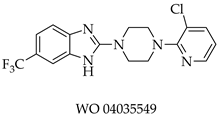
3.7. Protein Kinase Inhibitors

3.8. Miscellaneous

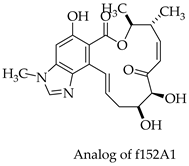
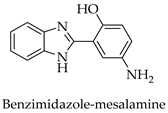
4. Summary and Perspectives
5. Conclusions
Author Contributions
Funding
Institutional Review Board Statement
Informed Consent Statement
Data Availability Statement
Acknowledgments
Conflicts of Interest
References
- Hansson, G.K.; Libby, P. The Immune Response in Atherosclerosis: A Double-Edged Sword. Nat. Rev. Immunol. 2006, 6, 508–519. [Google Scholar] [CrossRef] [PubMed]
- Libby, P. Atherosclerosis: The New View. Sci. Am. 2002, 286, 46–55. [Google Scholar] [CrossRef] [PubMed]
- Medzhitov, R. Inflammation 2010: New Adventures of an Old Flame. Cell 2010, 140, 771–776. [Google Scholar] [CrossRef] [Green Version]
- Takeuchi, O.; Akira, S. Pattern Recognition Receptors and Inflammation. Cell 2010, 140, 805–820. [Google Scholar] [CrossRef] [Green Version]
- Poetker, D.M.; Reh, D.D. A Comprehensive Review of the Adverse Effects of Systemic Corticosteroids. Otolaryngol. Clin. 2010, 43, 753–768. [Google Scholar] [CrossRef]
- Harirforoosh, S.; Asghar, W.; Jamali, F. Adverse Effects of Nonsteroidal Antiinflammatory Drugs: An Update of Gastrointestinal, Cardiovascular and Renal Complications. J. Pharm. Pharm. Sci. 2013, 16, 821–847. [Google Scholar] [CrossRef] [Green Version]
- Day, R.O.; Graham, G.G. Non-Steroidal Anti-Inflammatory Drugs (NSAIDs). BMJ 2013, 346. [Google Scholar] [CrossRef] [Green Version]
- Domanskyi, A.; Geißler, C.; Vinnikov, I.A.; Alter, H.; Schober, A.; Vogt, M.A.; Gass, P.; Parlato, R.; Schütz, G. Pten Ablation in Adult Dopaminergic Neurons Is Neuroprotective in Parkinson’s Disease Models. FASEB J. 2011, 25, 2898–2910. [Google Scholar] [CrossRef]
- Kaur, G.; Silakari, O. Benzimidazole Scaffold Based Hybrid Molecules for Various Inflammatory Targets: Synthesis and Evaluation. Bioorg. Chem. 2018, 80, 24–35. [Google Scholar] [CrossRef]
- Kumar, B.; Kumar, R.; Skvortsova, I.; Kumar, V. Mechanisms of Tubulin Binding Ligands to Target Cancer Cells: Updates on Their Therapeutic Potential and Clinical Trials. Curr. Cancer Drug Targets 2017, 17, 357–375. [Google Scholar] [CrossRef]
- Dhiman, P.; Arora, N.; Thanikachalam, P.V.; Monga, V. Recent Advances in the Synthetic and Medicinal Perspective of Quinolones: A Review. Bioorg. Chem. 2019, 92, 103291. [Google Scholar] [CrossRef]
- Sharma, S.; Kumar, D.; Singh, G.; Monga, V.; Kumar, B. Recent Advancements in the Development of Heterocyclic Anti-Inflammatory Agents. Eur. J. Med. Chem. 2020, 200, 112438. [Google Scholar] [CrossRef] [PubMed]
- Narasimhan, B.; Sharma, D.; Kumar, P. Benzimidazole: A Medicinally Important Heterocyclic Moiety. Med. Chem. Res. 2012, 21, 269–283. [Google Scholar] [CrossRef]
- Bansal, Y.; Silakari, O. The Therapeutic Journey of Benzimidazoles: A Review. Bioorg. Med. Chem. 2012, 20, 6208–6236. [Google Scholar] [CrossRef]
- Ingle, R.G.; Magar, D.D. Heterocyclic Chemistry of Benzimidazoles and Potential Activities of Derivatives. Int. J. Drug Res. Technol. 2011, 1, 26–32. [Google Scholar]
- Paramashivappa, R.; Kumar, P.P.; Rao, P.V.S.; Rao, A.S. Design, Synthesis and Biological Evaluation of Benzimidazole/ Benzothiazole and Benzoxazole Derivatives as Cyclooxygenase Inhibitors Bioorg. Med. Chem. Lett. 2003, 13, 657–660. [Google Scholar] [CrossRef]
- Bukhari, S.N.A.; Lauro, G.; Jantan, I.; Fei Chee, C.; Amjad, M.W.; Bifulco, G.; Sher, H.; Abdullah, I.; Rahman, N.A. Antiinflammatory Trends of New Benzimidazole Derivatives. Future Med. Chem. 2016, 8, 1953–1967. [Google Scholar] [CrossRef]
- Cheng, Y.; Hitchcock, S.A. Targeting Cannabinoid Agonists for Inflammatory and Neuropathic Pain. Expert Opin. Investig. Drugs 2007, 16, 951–965. [Google Scholar] [CrossRef] [PubMed]
- Watson, C.; Owen, D.R.; Harding, D.; Kon-I, K.; Lewis, M.L.; Mason, H.J.; Matsumizu, M.; Mukaiyama, T.; Rodriguez-Lens, M.; Shima, A.; et al. Optimisation of a Novel Series of Selective CNS Penetrant CB2 Agonists. Bioorg. Med. Chem. Lett. 2011, 21, 4284–4287. [Google Scholar] [CrossRef]
- Gijsen, H.J.M.; Cleyn, M.A.J.D.; Surkyn, M.; Van Lommen, G.R.E.; Verbist, B.M.P.; Nijsen, M.J.M.A.; Meert, T.; Wauwe, J.V.; Aerssens, J. 5-Sulfonyl-Benzimidazoles as Selective CB2 Agonists-Part 2. Bioorg. Med. Chem. Lett. 2012, 22, 547–552. [Google Scholar] [CrossRef]
- Sondhi, S.M.; Singh, N.; Kumar, A.; Lozach, O.; Meijer, L. Synthesis, Anti-Inflammatory, Analgesic and Kinase (CDK-1, CDK-5 and GSK-3) Inhibition Activity Evaluation of Benzimidazole/Benzoxazole Derivatives and Some Schiff’s Bases. Bioorg. Med. Chem. 2006, 14, 3758–3765. [Google Scholar] [CrossRef]
- Dombroski, M.A.; Letavic, M.A.; McClure, K.F. Benzimidazole Anti-Inflammatory Compounds. U.S. Patent 7056918, 19 September 2002. [Google Scholar]
- Anderskewitz, R.; Birke, F.; Bouyssou, T.; Dollinger, H.; Martyres, D.; Pouzet, P. Haloalkyl-and Piperidine-Substituted Benzimidazole-Derivatives. U.S. Patent 7157471, 2 January 2007. [Google Scholar]
- Mader, M.; de Dios, A.; Shih, C.; Bonjouklian, R.; Li, T.; White, W.; López de Uralde, B.; Sánchez-Martinez, C.; del Prado, M.; Jaramillo, C.; et al. Imidazolyl Benzimidazoles and Imidazo[4,5-b]Pyridines as Potent P38alpha MAP Kinase Inhibitors with Excellent in Vivo Antiinflammatory Properties. Bioorg. Med. Chem. Lett. 2008, 18, 179–183. [Google Scholar] [CrossRef] [PubMed]
- Guo, Q.; Chandrasekhar, J.; Ihle, D.; Wustrow, D.J.; Chenard, B.L.; Krause, J.E.; Hutchison, A.; Alderman, D.; Cheng, C.; Cortright, D.; et al. 1-Benzylbenzimidazoles: The Discovery of a Novel Series of Bradykinin B1 Receptor Antagonists. Bioorg. Med. Chem. Lett. 2008, 18, 5027–5031. [Google Scholar] [CrossRef]
- Zischinsky, G.; Stragies, R.; Schaudt, M.; Pfeifer, J.R.; Gibson, C.; Locardi, E.; Scharn, D.; Richter, U.; Kalkhof, H.; Dinkel, K.; et al. Novel Small Molecule Bradykinin B1 Receptor Antagonists. Part 2: 5-Membered Diaminoheterocycles. Bioorg. Med. Chem. Lett. 2010, 20, 1229–1232. [Google Scholar] [CrossRef] [PubMed]
- Dios, A.D.; Shih, C.B.; Uralde, L.D.; Sanchez, C.; Prado, M.D.; Cabrejas, M.M. Design of Potent and Selective 2-Aminobenzimidazole-Based P38a MAP Kinase Inhibitors with Excellent in Vivo Efficacy. J. Med. Chem. 2005, 48, 2270–2273. [Google Scholar] [CrossRef] [PubMed]
- Powers, J.P.; Li, S.; Jaen, J.C.; Liu, J.; Walker, N.P.C.; Wang, Z.; Wesche, H. Discovery and Initial SAR of Inhibitors of Interleukin-1 Receptor-Associated Kinase-4. Bioorg. Med. Chem. Lett. 2006, 16, 2842–2845. [Google Scholar] [CrossRef]
- Frenkel, A.D.; Lively, S.E.; Powers, J.P.; Smith, A.; Sun, D.; Tomooka, C.; Wang, Z. Benzimidazole Derivatives. U.S. Patent 7635774, 25 February 2010. [Google Scholar]
- Hayes, M.E.; Wallace, G.A.; Grongsaard, P.; Bischoff, A.; George, D.M.; Miao, W.; McPherson, M.J.; Stoffel, R.H.; Green, D.W.; Roth, G.P. Discovery of Small Molecule Benzimidazole Antagonists of the Chemokine Receptor CXCR3. Bioorg. Med. Chem. Lett. 2008, 18, 1573–1576. [Google Scholar] [CrossRef]
- Sabat, M.; VanRens, J.C.; Laufersweiler, M.J.; Brugel, T.A.; Maier, J.; Golebiowski, A.; De, B.; Easwaran, V.; Hsieh, L.C.; Walter, R.L.; et al. The Development of 2-Benzimidazole Substituted Pyrimidine Based Inhibitors of Lymphocyte Specific Kinase (Lck). Bioorg. Med. Chem. Lett. 2006, 16, 5973–5977. [Google Scholar] [CrossRef] [PubMed]
- Chen, J.J.; Thakur, K.D.; Clark, M.P.; Laughlin, S.K.; George, K.M.; Bookland, R.G.; Davis, J.R.; Cabrera, E.J.; Easwaran, V.; De, B.; et al. Development of Pyrimidine-Based Inhibitors of Janus Tyrosine Kinase 3. Bioorg. Med. Chem. Lett. 2006, 16, 5633–5638. [Google Scholar] [CrossRef] [PubMed]
- Martin, M.W.; Newcomb, J.; Nunes, J.J.; Boucher, C.; Chai, L.; Epstein, L.F.; Faust, T.; Flores, S.; Gallant, P.; Gore, A.; et al. Structure-Based Design of Novel 2-Amino-6-Phenylpyrimido[50,40:5,6]Pyrimido[1,2-a]Benzimidazol-5(6H)-Ones as Potent and Orally Active Inhibitors of Lymphocyte Specific Kinase (Lck): Synthesis, SAR and in Vivo Anti-Inflammatory Activity. J. Med. Chem. 2008, 51, 1637–1648. [Google Scholar] [CrossRef]
- Hunt, J.A.; Beresis, R.T.; Goulet, J.L.; Holmes, M.A.; Hong, X.J.; Kovacs, E.; Mills, S.G.; Ruzek, R.D.; Wong, F.; Hermes, J.D.; et al. Disubstituted Pyrimidines as Lck Inhibitors. Bioorg. Med. Chem. Lett. 2009, 19, 5440–5443. [Google Scholar] [CrossRef]
- Banoglu, E.; Çalişkan, B.; Luderer, S.; Eren, G.; Özkan, Y.; Altenhofen, W.; Weinigel, C.; Barz, D.; Gerstmeier, J.; Pergola, C.; et al. Identification of Novel Benzimidazole Derivatives as Inhibitors of Leukotriene Biosynthesis by Virtual Screening Targeting 5-Lipoxygenase-Activating Protein (FLAP). Bioorg. Med. Chem. 2012, 20, 3728–3741. [Google Scholar] [CrossRef]
- Evans, J.F.; Ferguson, A.D.; Mosley, R.T.; Hutchinson, J.H. What’s All the FLAP about? 5-Lipoxygenase-Activating Protein Inhibitors for Inflammatory Diseases. Trends Pharmacol. Sci. 2008, 29, 72–78. [Google Scholar] [CrossRef] [PubMed]
- Hutchinson, H.; Li, Y.; Arruda, J.M.; Baccei, C.; Bain, G.; Chapman, C.; Correa, L.; Darlington, J.; King, C.D.; Lee, C.; et al. 5-Lipoxygenase-Activating Protein Inhibitors: Development of 3-[3-Tert-Butylsulfanyl-1-[4-(6-Methoxy-Pyridin-3-Yl)- Benzyl]-5-(Pyridin-2-Ylmethoxy)-1H-Indol-2-Yl] -2,2-Dimethyl-Propionic Acid (AM103). J. Med. Chem. 2009, 52, 5803–5815. [Google Scholar] [CrossRef] [PubMed]
- Stock, N.; Baccei, C.; Bain, G.; Chapman, C.; Correa, L.; Darlington, J.; King, C.; Lee, C.; Lorrain, D.S.; Prodanovich, P.; et al. 5-Lipoxygenase-Activating Protein Inhibitors. Part 3: 3-{3-Tert- Butylsulfanyl-1-[4-(5-Methoxy-Pyrimidin-2-Yl)-Benzyl]-5-(5-Methyl-Pyridin-2-Ylmethoxy)-1H-Indol-2-Yl]-2,2-Dimethyl-Propionic Acid (AM643)-A Potent FLAP Inhibitor Suitable for Topical Administration. Bioorg. Med. Chem. Lett. 2010, 20, 4598–4601. [Google Scholar]
- Stock, N.; Baccei, C.; Bain, G.; Broadhead, A.; Chapman, C.; Darlington, J.; King, C.; Lee, C.; Li, Y.; Lorrain, D.S.; et al. 5-Lipoxygenase-Activating Protein Inhibitors. Part 2: 3-{5-((S)-1-Acetyl-2,3-Dihydro-1H-Indol-2-Ylmethoxy)-3-Tert-Butylsulfanyl-1-[4-(5-Methoxy-Pyrimidin-2-Yl)-Benzyl]-1H-Indol-2-Yl}-2,2-Dimethyl-Propionic Acid (AM679)-a Potent FLAP Inhibitor. Bioorg. Med. Chem. Lett. 2010, 20, 213–217. [Google Scholar] [CrossRef] [PubMed]
- Stock, N.S.; Bain, G.; Zunic, J.; Li, Y.; Ziff, J.; Roppe, J.; Santini, A.; Darlington, J.; Prodanovich, P.; King, C.D.; et al. 5-Lipoxygenase activating Protein (FLAP) Inhibitors. Part 4: Development of 3-[3-Tert-Butylsulfanyl- 1-[4-(6-Ethoxypyridin-3-Yl) Benzyl]-5-(5-Methylpyridin-2- Ylmethoxy)-1H-Indol-2-Yl]-2,2-Dimethylpropionic Acid (AM803), a Potent, Oral, Once Daily FLAP Inhibitor. J. Med. Chem. 2011, 54, 8013–8029. [Google Scholar]
- Ognyanov, V.I.; Balan, C.; Bannon, A.W.; Bo, Y.; Dominguez, C.; Fotsch, C.; Gore, V.K.; Klionsky, L.; Ma, V.V.; Qian, Y.X.; et al. Design of Potent, Orally Available Antagonists of the Transient Receptor Potential Vanilloid 1. Structureeactivity Relationships of 2-Piperazin-1-Yl-1H Benzimidazoles. J. Med. Chem. 2006, 49, 3719–3742. [Google Scholar] [CrossRef]
- Rami, H.K.; Gunthorpe, M.J. The Therapeutic Potential of TRPV1 (VR1) Antagonists: Clinical Answers Await. Drug Discov. Today Ther. Strateg. 2004, 1, 97–104. [Google Scholar] [CrossRef]
- Fletcher, S.R.; McIver, E.; Lewis, S.; Burkamp, F.; Leech, C.; Mason, G.; Boyce, S.; Morrison, D.; Richards, G.; Sutton, K.; et al. The Search for Novel TRPV1- Antagonists: From Carboxamides to Benzimidazoles and Indazolones. Bioorg. Med. Chem. Lett. 2006, 16, 2872–2876. [Google Scholar] [CrossRef]
- Bamborough, P.; Christopher, J.A.; Cutler, G.J.; Dickson, M.C.; Mellor, G.W.; Morey, J.V.; Patel, C.B.; Shewchuk, L.M. 5-(1H-Benzimidazol-1-Yl)-3-Alkoxy-2-Thiophenecarbonitriles as Potent, Selective, Inhibitors of IKK-Epsilon Kinase. Bioorg. Med. Chem. Lett. 2006, 16, 6236–6240. [Google Scholar] [CrossRef]
- Rajasekaran, S.; Rao, G.; Chatterjee, A. Synthesis, Anti-Inflammatory and Antioxidant Activity of Some Substituted Benzimidazole Derivatives. Int. J. Drug Dev. Res. 2012, 4, 303–309. [Google Scholar]
- Rao, G.M.; Reddy, Y.N.; Kumar, B.V. Evaluation of Analgesic and Antiinflammatory Activities of N-Mannich Bases of Substituted 2-Mercapto-1Hbenzimidazoles. Int. J. Appl. Biol. Pharm. Technol. 2013, 4, 38–46. [Google Scholar]
- Kankala, S.; Kankala, R.K.; Gundepaka, P.; Thota, N.; Nerella, S.; Gangula, M.R.; Guguloth, H.; Kagga, M.; Vadde, R.; Vasam, C.S. Regioselective Synthesis of Isoxazole-Mercapto Benzimidazole Hybrids and Their in Vivo Analgesic and Anti-Inflammatory Activity Studies. Bioorg. Med. Chem. Lett. 2013, 23, 1306–1309. [Google Scholar] [CrossRef]
- Mariappan, G.; Bhuyan, N.R.; Kumar, P.; Kumar, D.; Murali, K. Synthesis and Biological Evaluation of Mannich Bases of Benzimidazole Derivatives. Ind. J. Chem. 2011, 50, 1216–1219. [Google Scholar]
- Gaba, M.; Singh, D.; Singh, S.; Sharma, V.; Gaba, P. Synthesis and Pharmacological Evaluation of Novel 5-Substituted-1- (Phenylsulfonyl)-2-Methylbenzimidazole Derivatives as Anti-Inflammatory and Analgesic Agents. Eur. J. Med. Chem. 2010, 45, 2245–2249. [Google Scholar] [CrossRef]
- Dunwell, D.W.; Evans, D.; Smith, C.E.; Williamson, W.R. Synthesis and Antiinflammatory Activity of Some-2-Substituted Alpha-Methyl-5-Benzimidazoleacetic Acids. J. Med. Chem. 1975, 18, 692–694. [Google Scholar] [CrossRef]
- Evans, D.; Hicks, T.A.; Williamson, W.R.N.; Dawson, W.; Meacock, S.C.R.; Kitchen, E.A. Synthesis of a Group of 1H--Benzimidazoles and Their Screening for Antiinflammatory Activity. Eur. J. Med. Chem. 1996, 31, 635–642. [Google Scholar] [CrossRef]
- Terzioglu, N.; van Rijn, R.M.; Bakker, R.A.; De Esch, I.J.P.; Leurs, R. Synthesis and Structure-Activity Relationships of Indole and Benzimidazole Piperazines as Histamine H(4) Receptor Antagonists. Bioorg. Med. Chem. Lett. 2004, 14, 5251–5256. [Google Scholar] [CrossRef] [PubMed]
- Coruzzi, G.; Adami, M.; Guaita, E.; de Esch, I.J.P.; Leurs, R. Antiinflammatory and Antinociceptive Effects of the Selective Histamine H4-Receptor Antagonists JNJ7777120 and VUF6002 in a Rat Model of Carrageenan-Induced Acute Inflammation. Eur. J. Pharmacol. 2007, 563, 240–244. [Google Scholar] [CrossRef]
- Richards, M.L.; Lio, S.C.; Sinha, A.; Banie, H.; Thomas, R.J.; Major, M.; Tanji, M.; Sircar, J.C. Substituted 2-Phenyl- Benzimidazole Derivatives: Novel Compounds That Suppress Key Markers of Allergy. Eur. J. Med. Chem. 2006, 41, 950–969. [Google Scholar] [CrossRef]
- Taniguchi, K.; Shigenaga, S.; Ogahara, T.; Fujitsu, T.; Matsuo, M. Synthesis and Anti- Inflammatory and Analgesic Properties of 2-Amino-1H-Benzimidazole and 1,2-Dihydro-2- Iminocycloheptimidazole Derivatives. Chem. Pharm. Bull. 1993, 41, 301–309. [Google Scholar] [CrossRef] [PubMed] [Green Version]
- Shen, Y.; Boivin, R.; Yoneda, N.; Du, H.; Schiller, S.; Matsushima, T.; Goto, M.; Shirota, H.; Gusovsky, F.; Lemelin, C.; et al. Discovery of Antiinflammatory Clinical Candidate E6201, Inspired from Resorcylic Lactone LLZ1640-2, III. Bioorg. Med. Chem. Lett. 2010, 20, 3155–3157. [Google Scholar] [CrossRef]
- El-Nezhawy, A.O.H.; Gaballah, S.T.; Radwan, M.A.A.; Baiuomy, A.R.; Abdel-Salam, O.M. Structure-Based Design of Benzimidazole Sugar Conjugates: Synthesis, SAR and in Vivo Anti-Inflammatory and Analgesic Activities. Med. Chem. 2009, 5, 558–569. [Google Scholar] [CrossRef]
- Thakurdesai, P.A.; Wadodkar, S.G.; Chopade, C.T. Synthesis and Anti-Inflammatory Activity of Some Benzimidazole-2- Carboxylic Acids. Pharmacologyonline 2007, 1, 314–329. [Google Scholar]
- Toja, E.; Selva, D.; Schiatti, P. 3-Alkyl-2-Aryl-3H-Naphth[1,2-d]Imidazoles, a Novel Class of Non-acidic Anti-inflammatory Agents. J. Med. Chem. 1984, 27, 610–616. [Google Scholar] [CrossRef]
- Bansal, Y.; Silakari, O. Synthesis and Pharmacological Evaluation of Polyfunctional Benzimidazole-NSAID Chimeric Molecules Combining Antiinflammatory, Immunomodulatory and Antioxidant Activities. Arch. Pharm. Res. 2014, 37, 1426–1436. [Google Scholar] [CrossRef]
- Achar, K.C.S.; Hosamani, K.M.; Seetharamareddy, H.R. In-Vivo Analgesic and Anti-Inflammatory Activities of Newly Synthesized Benzimidazole Derivatives. Eur. J. Med. Chem. 2010, 45, 2048–2054. [Google Scholar] [CrossRef]
- Tsukamoto, G.; Yoshino, K.; Kohno, T.; Ohtaka, H.; Kagaya, H.; Ito, K. 2-Substituted Azole Derivatives. 1. Synthesis and Anti-inflammatory Activity of Some 2-(Substituted-Pyridinyl)Benzimidazoles. J. Med. Chem. 1980, 23, 734–738. [Google Scholar] [CrossRef] [PubMed]
- Ito, K.; Kagaya, H.; Fukuda, T.; Yoshino, K.; Nose, T. Pharmacological Studies of a New Non-Steroidal Antiinflammatory Drug: 2-(5-Ethylpyridin-2-Yl)Benzimidazole (KB-1043). Arzneimittel-forschung 1982, 32, 49–55. [Google Scholar]
- Ito, K.; Kagaya, H.; Satoh, I.; Tsukamoto, G.; Nose, T. The Studies of the Mechanism of Antiinflammatory Action of 2-(5-Ethylpyridin-2-Yl)Benzimidazole (KB-1043). Arzneimittel-forschung 1982, 32, 117–122. [Google Scholar]
- Ravindernath, A.; Reddy, M.S. Synthesis and Evaluation of Anti-Inflammatory, Antioxidant and Anti-microbial Activities of Densely Functionalised Novel Benzo [d] Imidazolyl Tetrahydropyridine Carboxylates. Arab. J. Chem. 2017, 10, S1172–S1179. [Google Scholar] [CrossRef]
- Shaaban, M.R.; Saleh, T.S.; Mayhoub, A.S.; Mansour, A.; Farag, A.M. Synthesis and Analgesic/Anti-Inflammatory Evaluation of Fused Heterocyclic Ring Systems Incorporating Phenylsulfonyl Moiety. Bioorg. Med. Chem. 2008, 16, 6344–6352. [Google Scholar] [CrossRef]
- El-Nezhawy, A.O.; Biuomy, A.R.; Hassan, F.S.; Ismaiel, A.K.; Omar, H.A. Design Synthesis and Pharmacological Evaluation of Omeprazole-like Agents with Anti-inflammatory Activity. Bioorg. Med. Chem. 2013, 21, 1661–1670. [Google Scholar] [CrossRef]
- Sondhi, S.M.; Rajvanshi, S.; Johar, M.; Bharti, N.; Azam, A.; Singh, A.K. Anti-Inflammatory, Analgesic and Antiamoebic Activity Evaluation of Pyrimido[1,6-a] Benzimidazole Derivatives Synthesised by the Reaction of Ketoisothiocyanates with Mono and Diamines. Eur. J. Med. Chem. 2002, 37, 835–843. [Google Scholar] [CrossRef]
- Sondhi, S.M.; Rani, R.; Singh, J.; Roy, P.; Agrawal, S.K.; Saxena, A.K. Solvent Free Synthesis, Anti-Inflammatory and Anticancer Activity Evaluation of Tricyclic and Tetracyclic Benzimidazole Derivatives. Bioorg. Med. Chem. Lett. 2010, 20, 2306–2310. [Google Scholar] [CrossRef] [PubMed]
- Mohammed, A.F.; Abdel-Moty, S.G.; Hussein, M.A.; Abdel-Alim, A.M. Design, Synthesis and Molecular Docking of Some New 1,2,4-Triazolobenzimidazol-3-Yl Acetohydrazide Derivatives with Anti-Inflammatory Analgesic Activities. Arch. Pharm. Res. 2013, 36, 1465–1479. [Google Scholar] [CrossRef]
- Mohamed, B.G.; Abdel-Alim, M.; Mostafa, A.H. Synthesis of 1-Acyl-2-Alkylthio-1,2,4-Triazolobenzimidazoles with Anti-fungal, Anti-Inflammatory and Analgesic Effects. Acta Pharm. 2006, 56, 31–48. [Google Scholar] [PubMed]
- Soni, J.P.; Sen, D.J.; Modh, K.M. Structure Activity Relationship Studies of Synthesised Pyrazolone Derivatives of Imidazole, Benzimidazole and Benztriazole Moiety for Anti-Inflammatory Activity. J. Appl. Pharm. Sci. 2011, 1, 115–120. [Google Scholar]
- Arora, R.K.; Kaur, N.; Bansal, Y.; Bansal, G. Novel Coumarin-Benzimidazole Derivatives as Antioxidants and Safer Anti-Inflammatory Agents. Acta Pharm. Sin. B 2014, 4, 368–375. [Google Scholar] [CrossRef] [Green Version]
- Sharma, R.; Bali, A.; Chaudhari, B.B. Synthesis of Methanesulphonamido-Benzimidazole Derivatives as Gastro-Sparing Anti-inflammatory Agents with Antioxidant Effect. Bioorg. Med. Chem. Lett. 2017, 27, 3007–3013. [Google Scholar] [CrossRef] [PubMed]

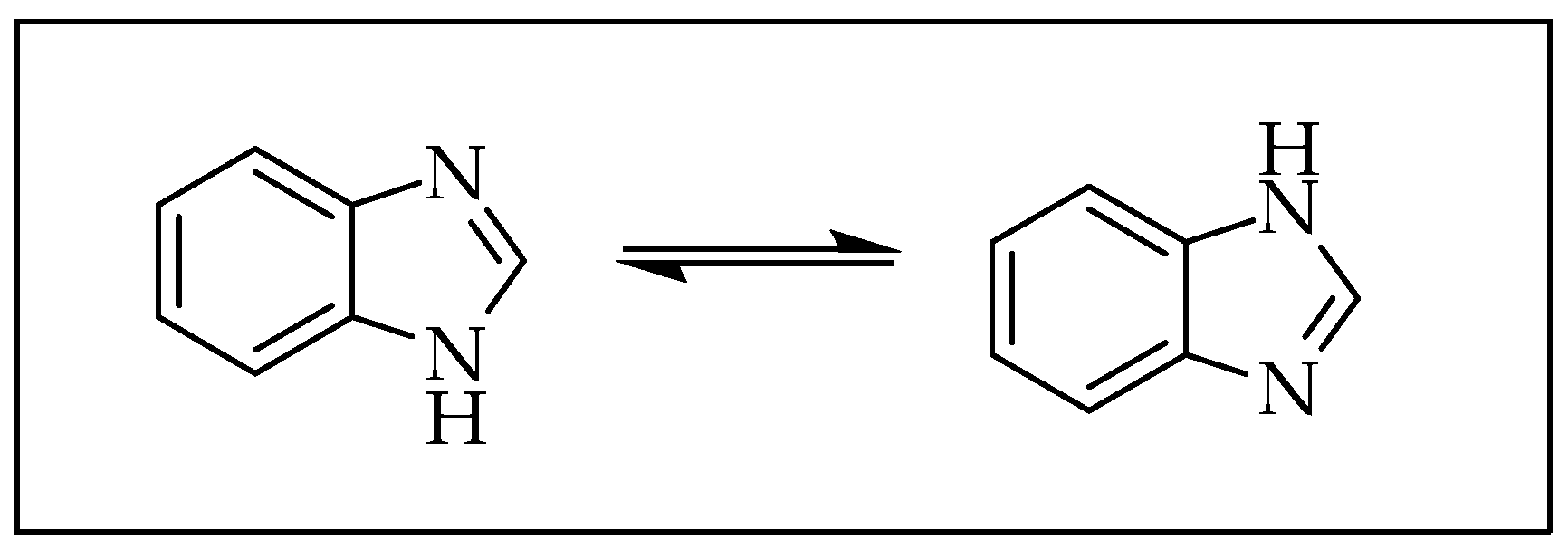


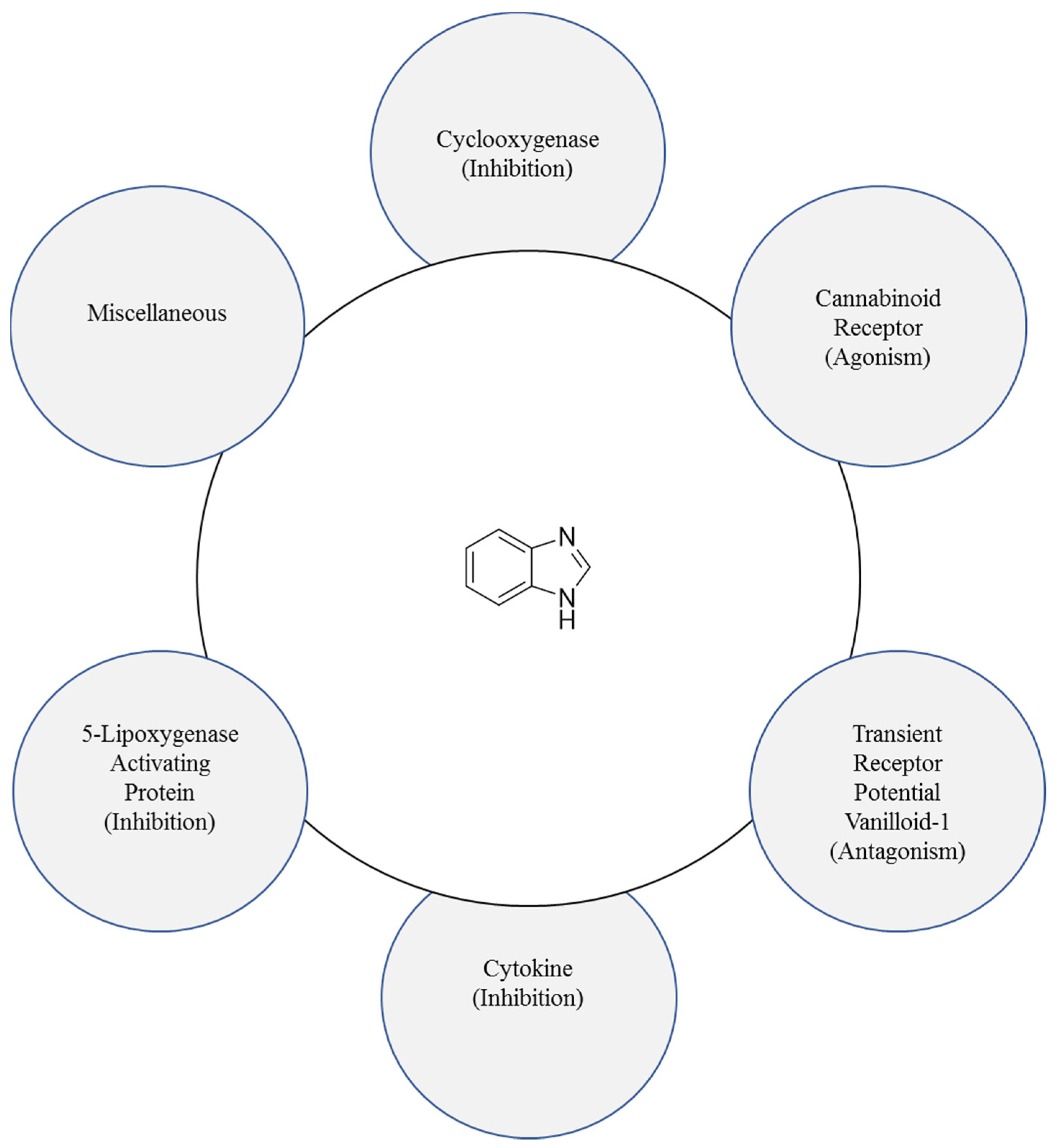
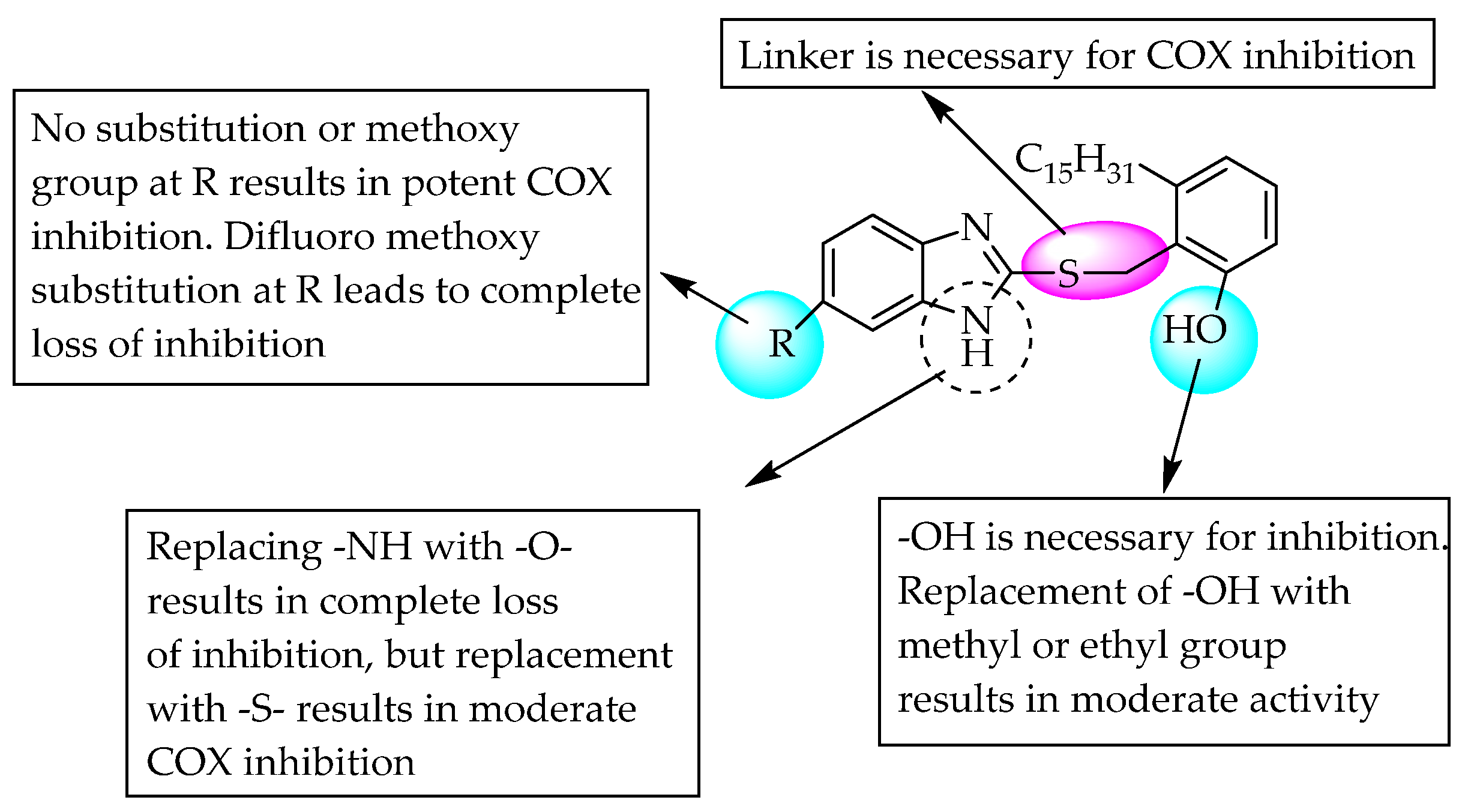

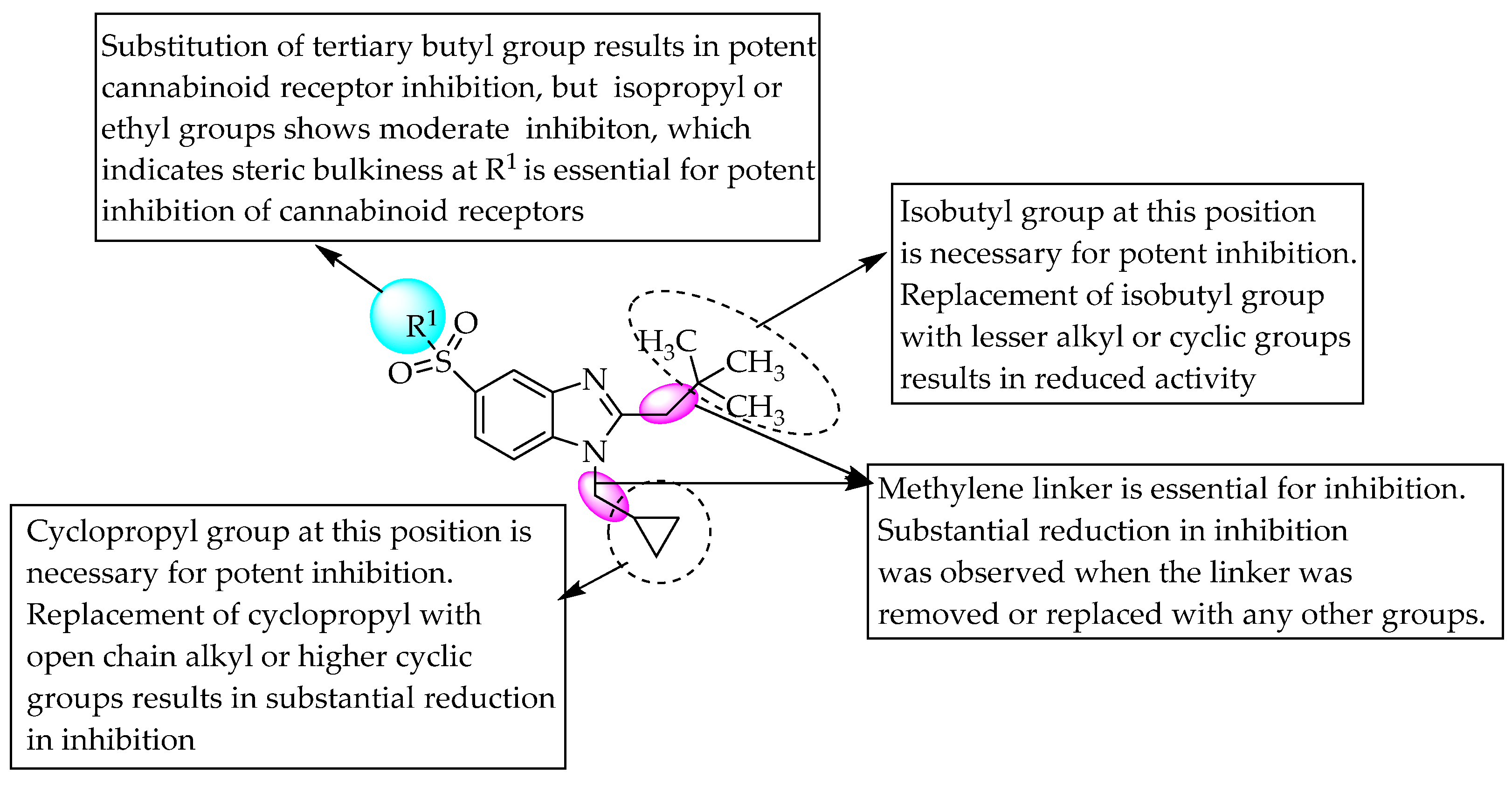
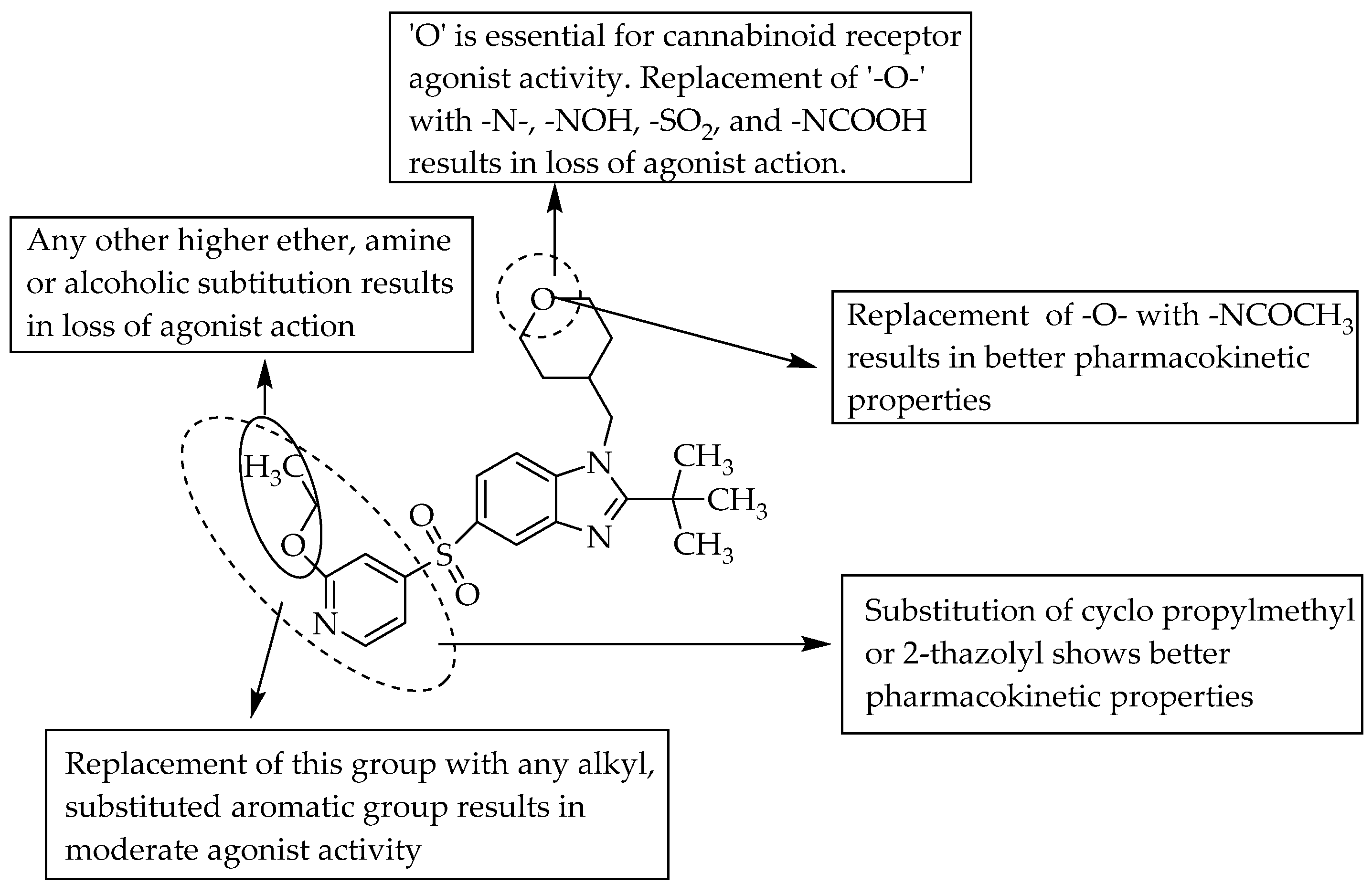
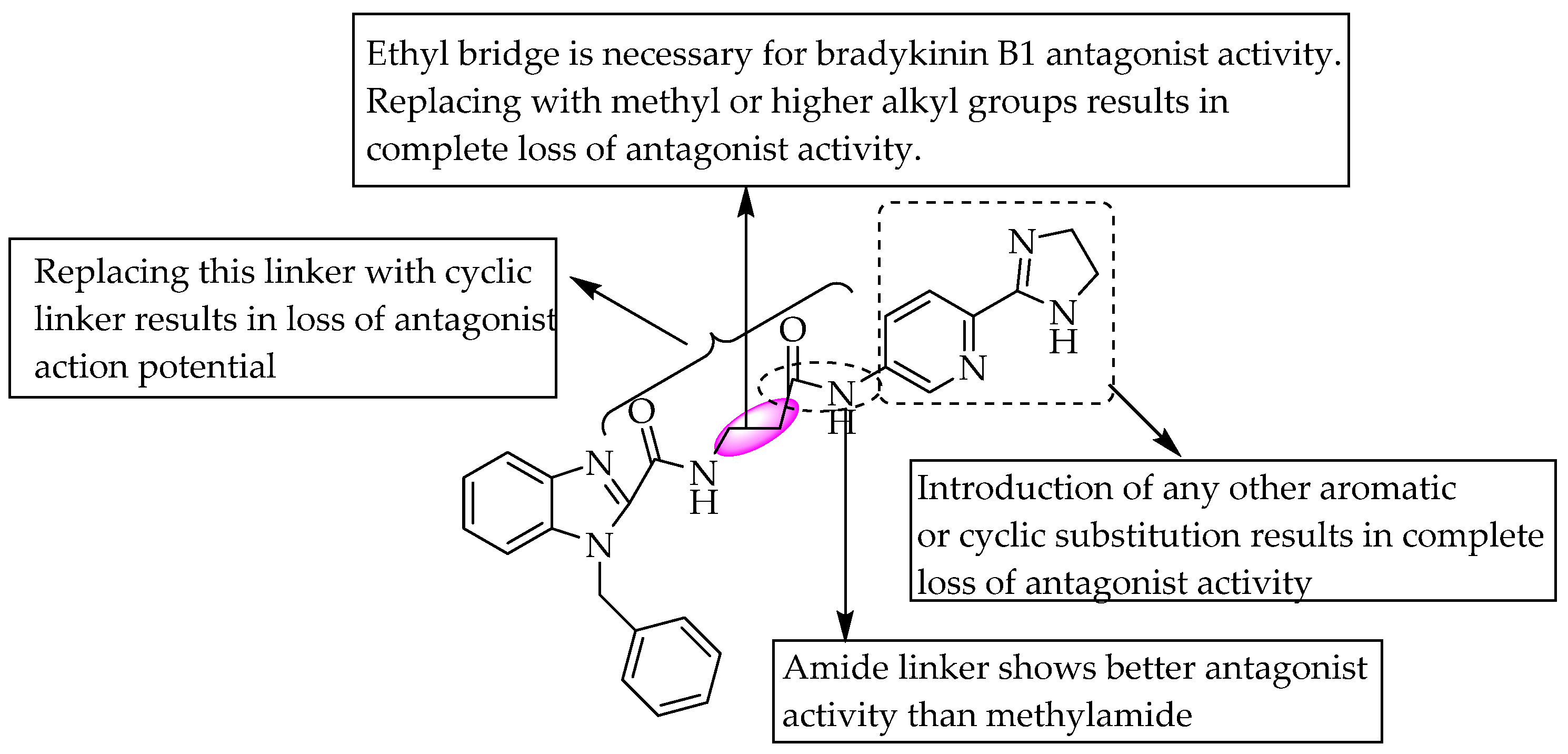





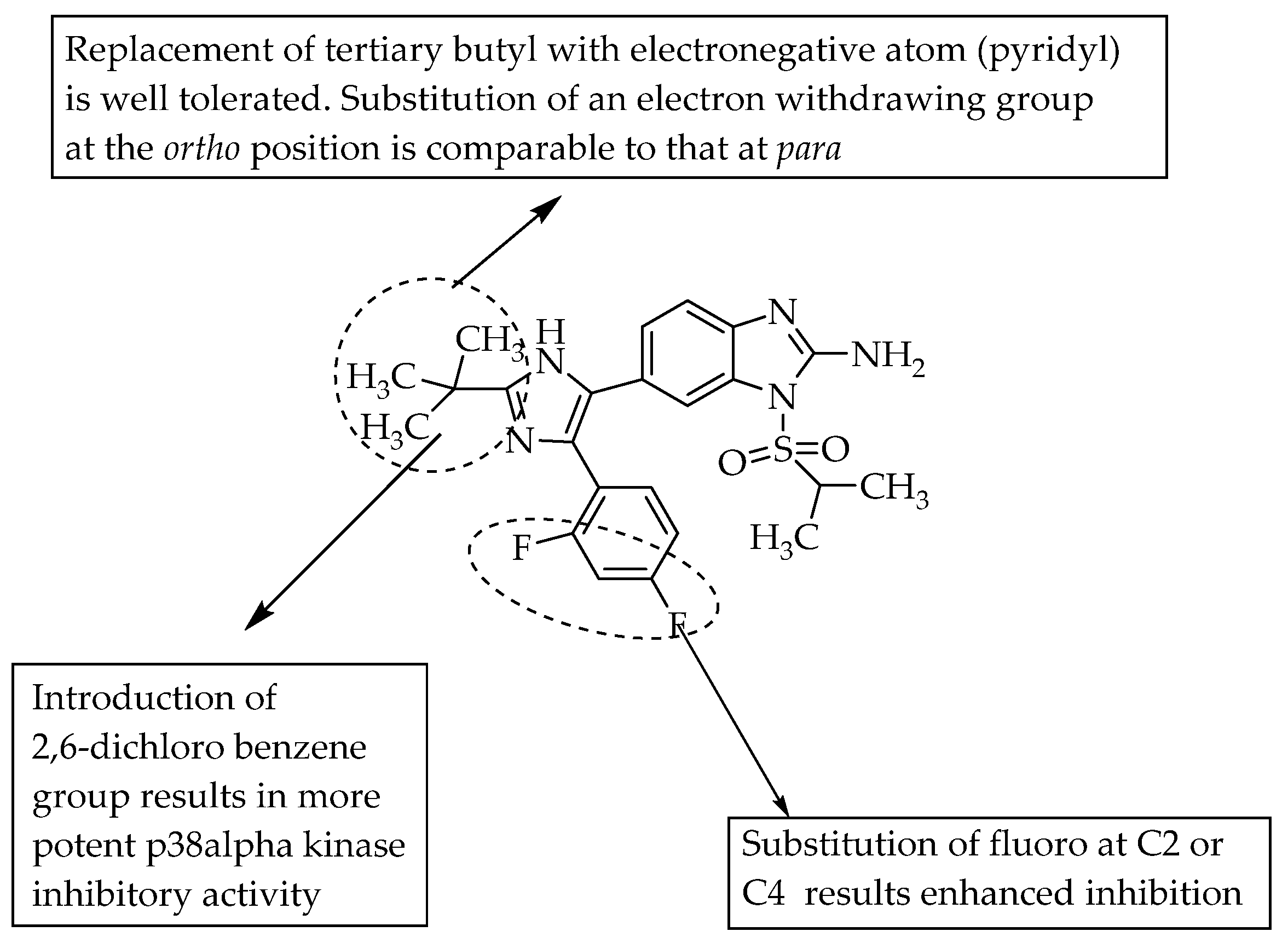


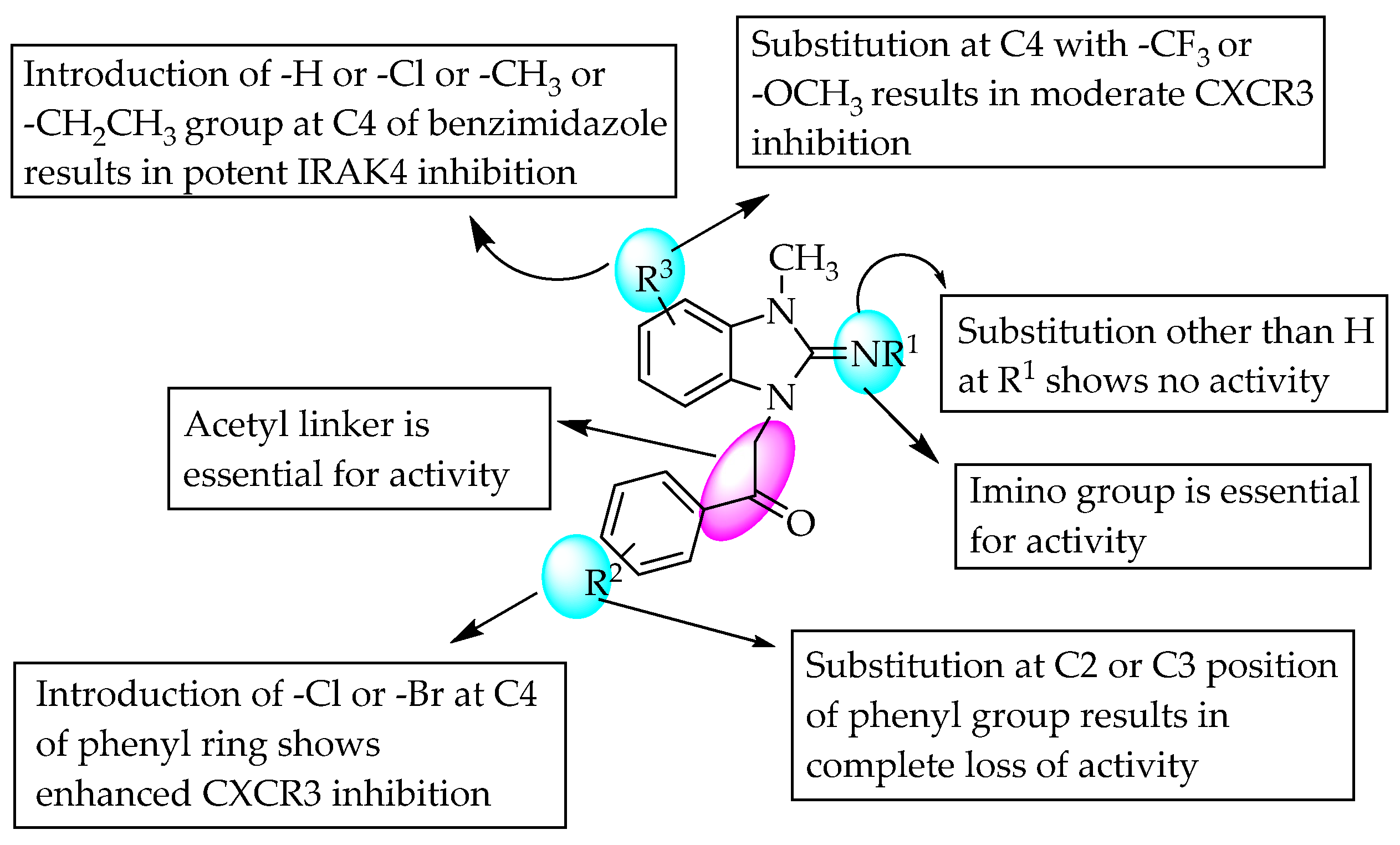
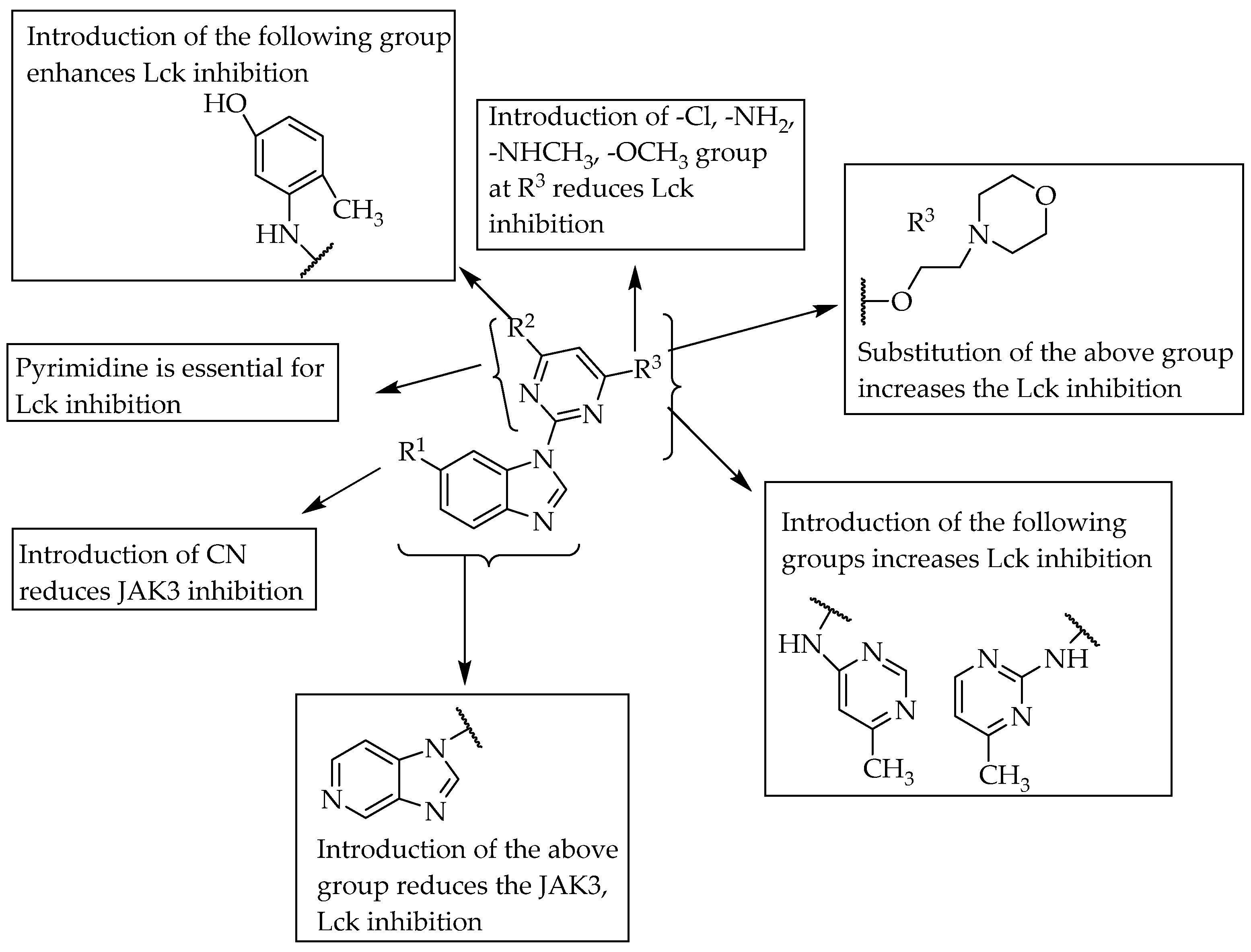



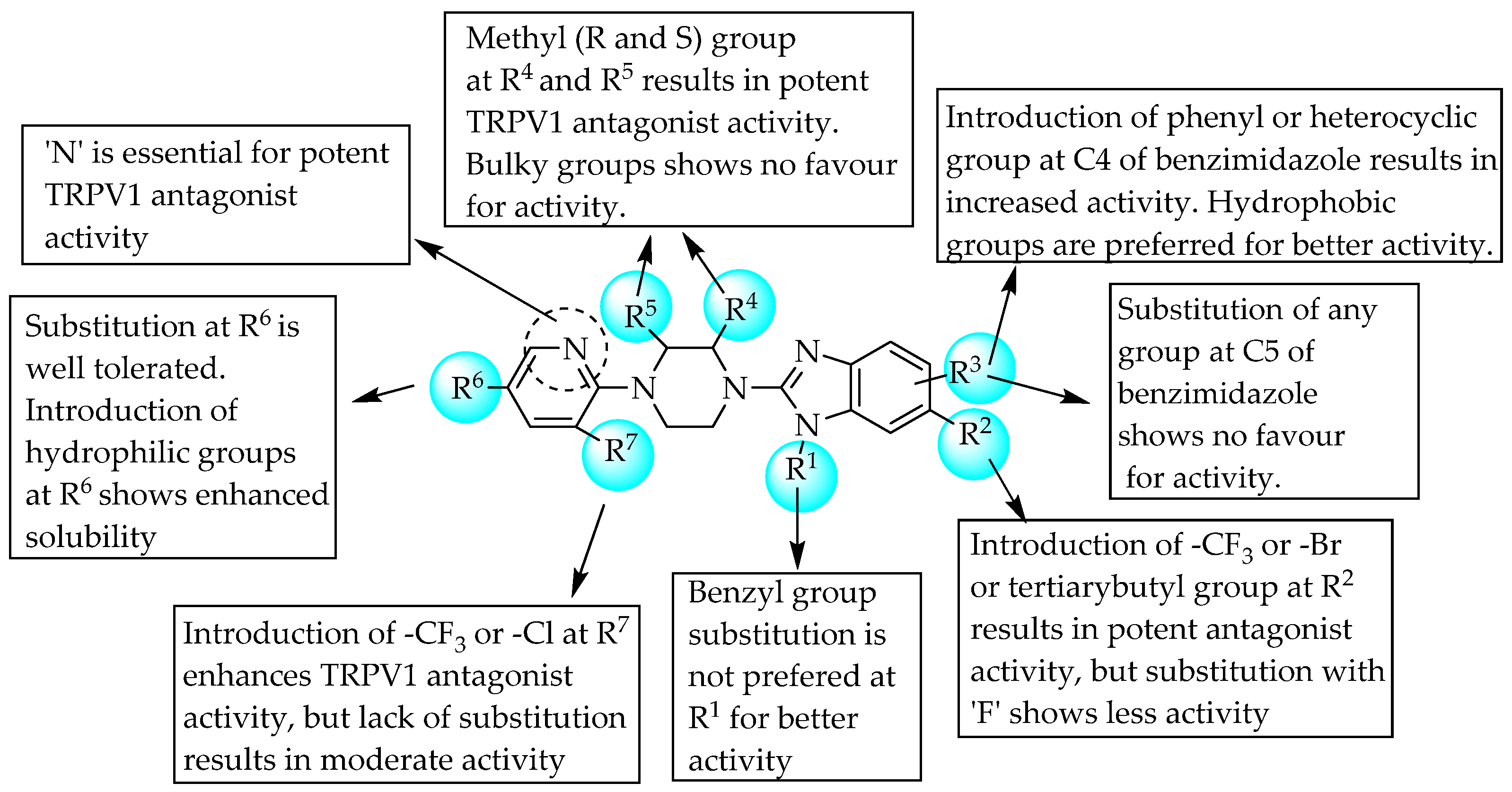

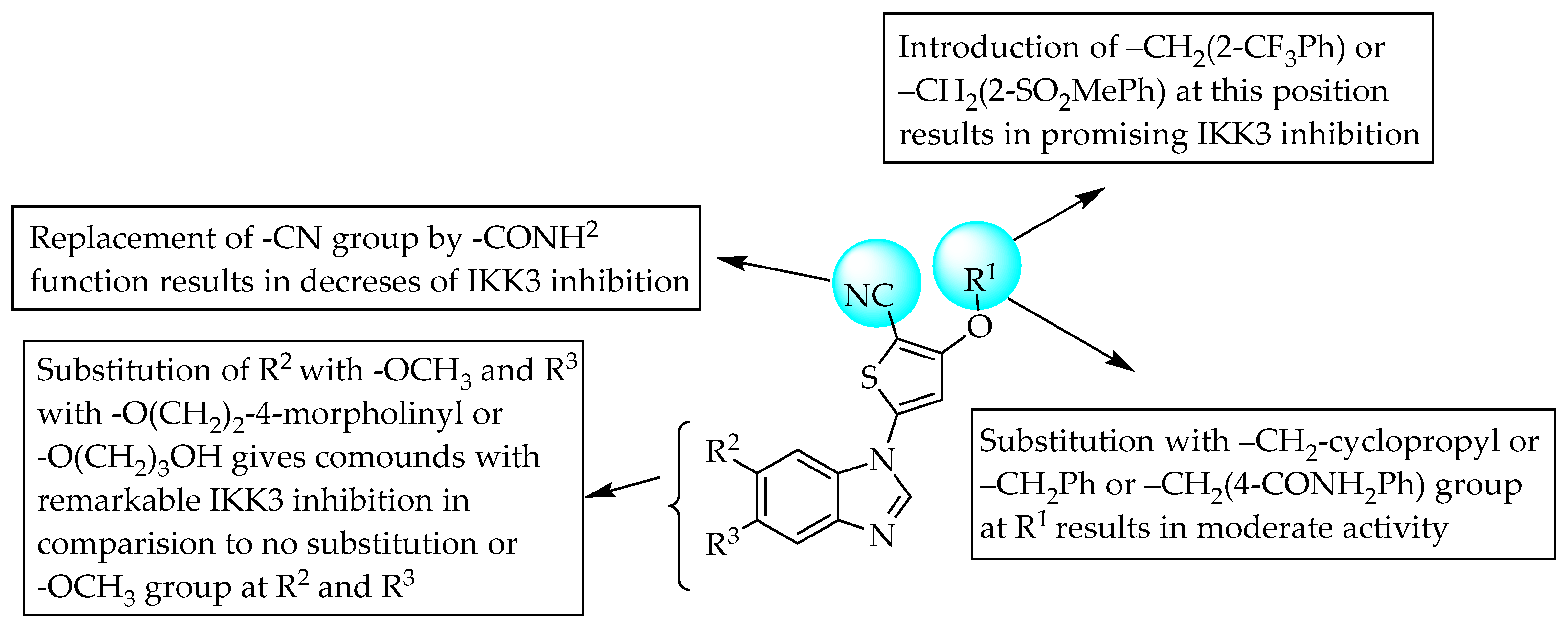

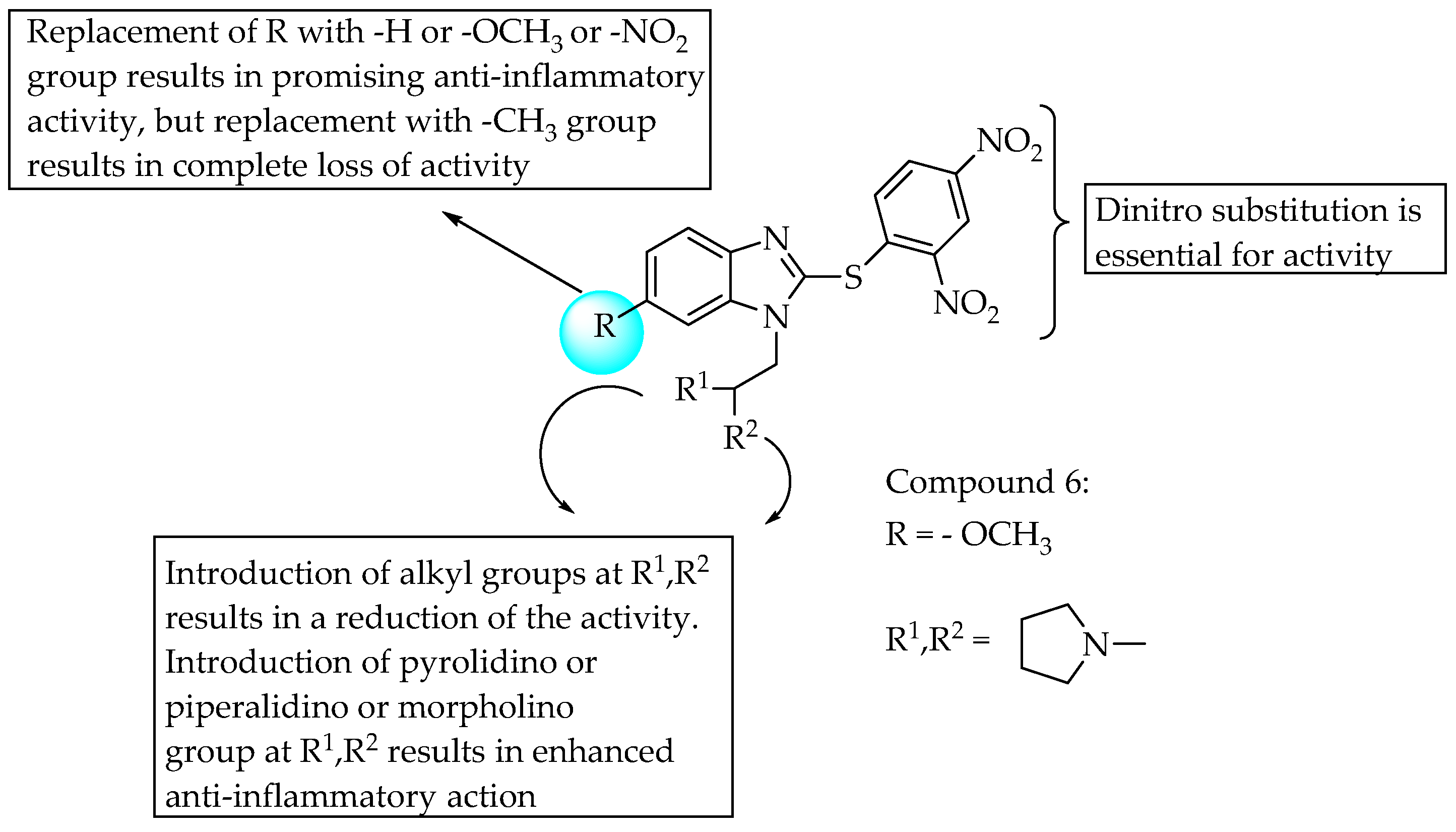
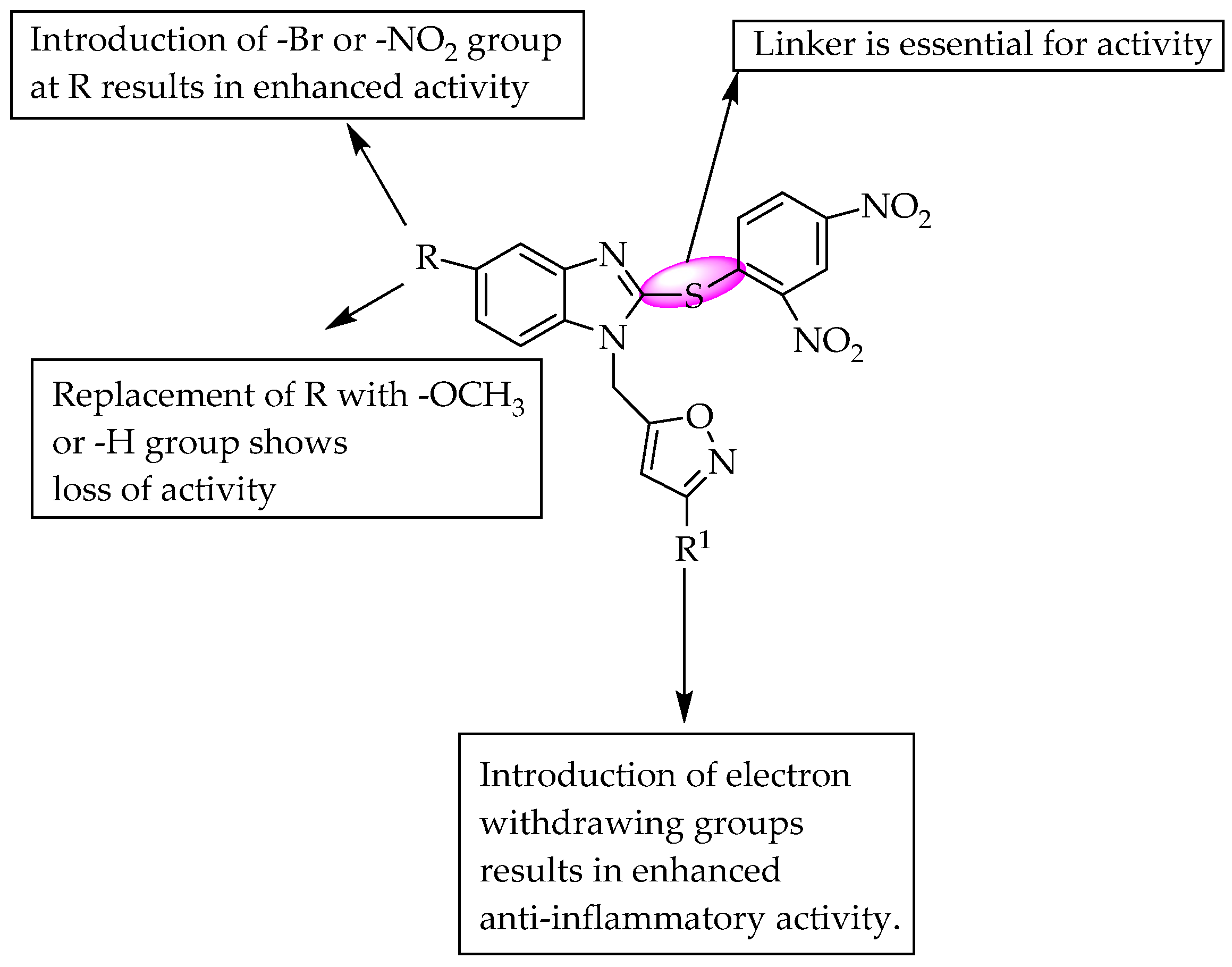


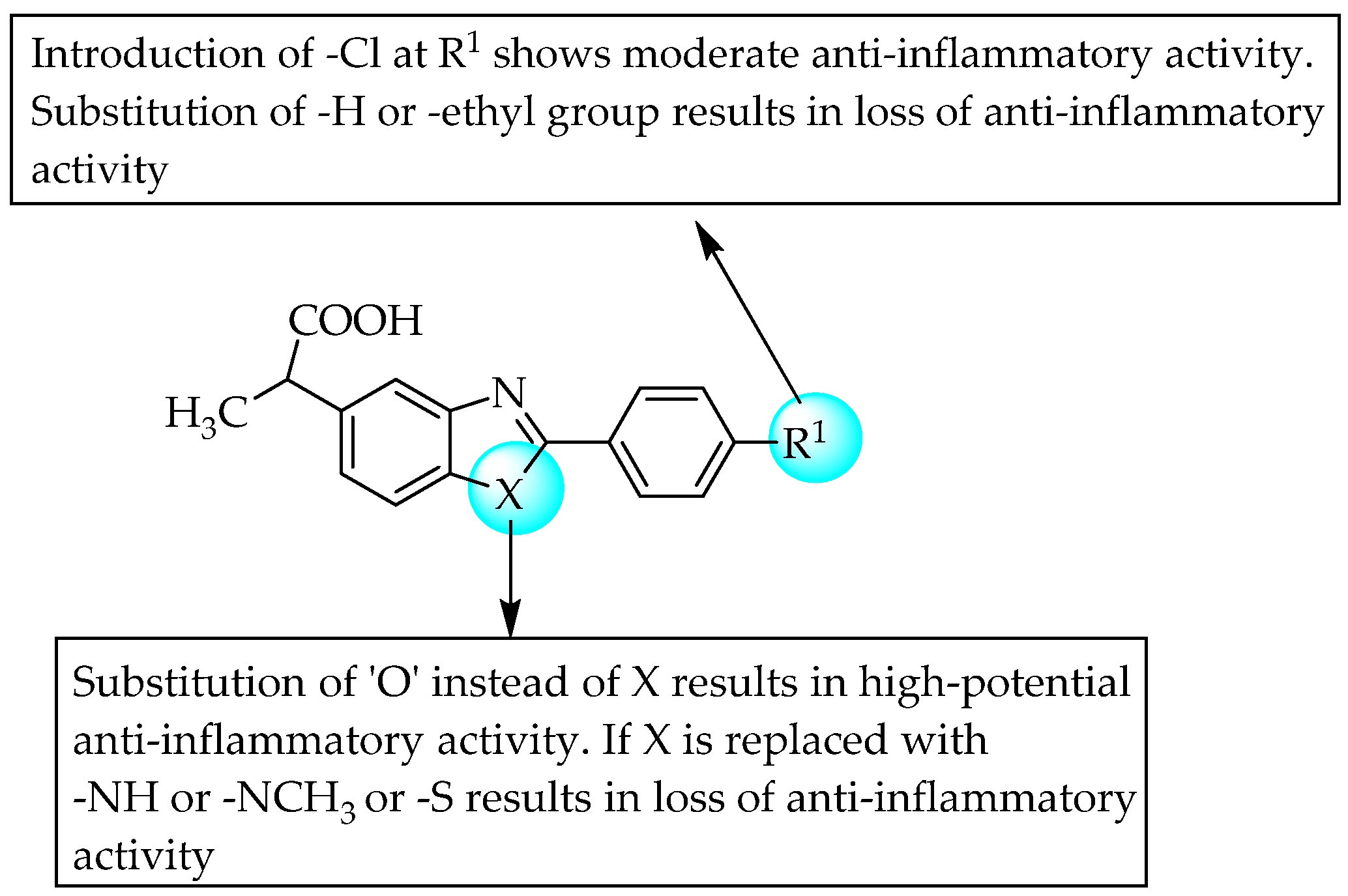


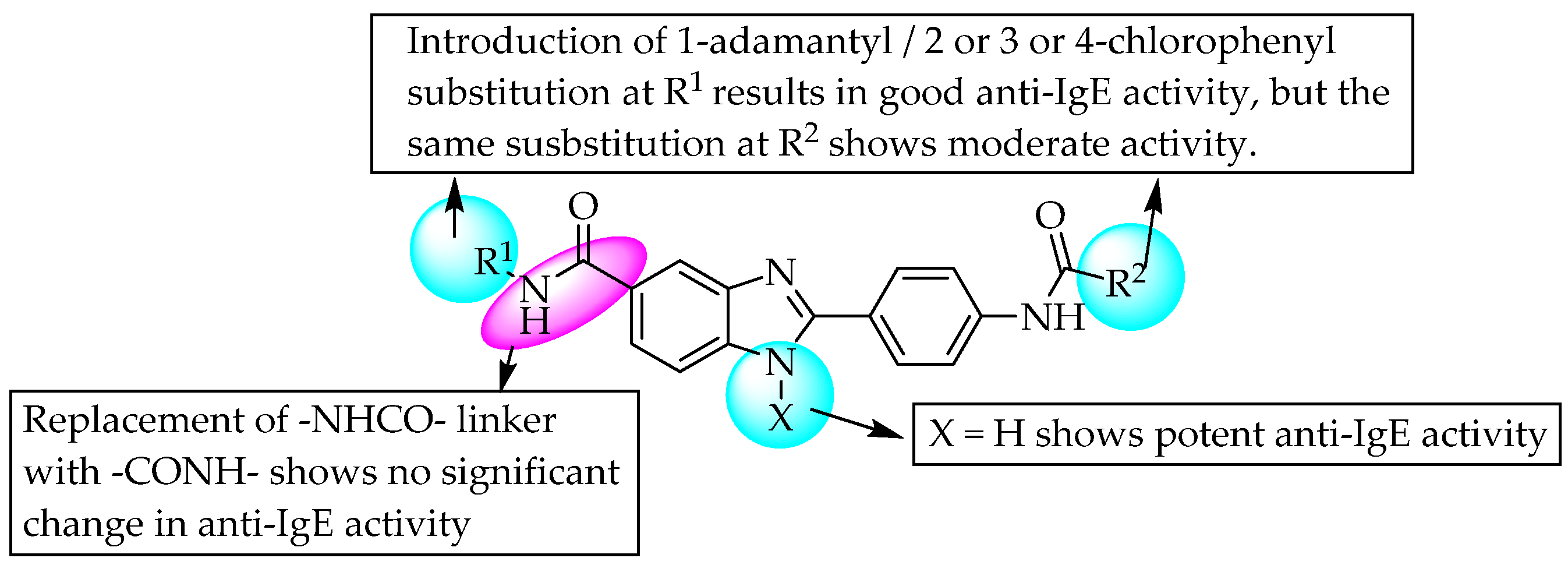


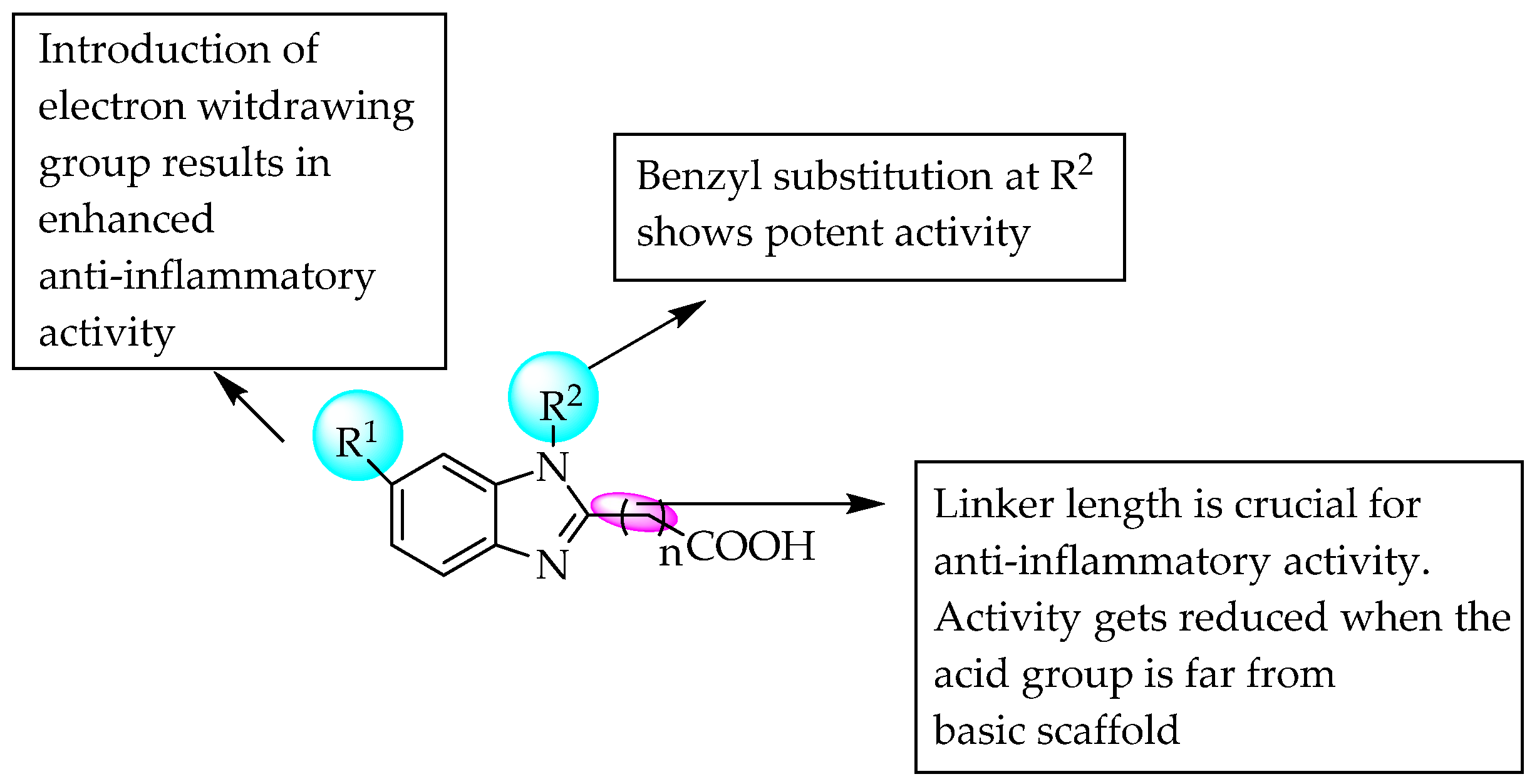

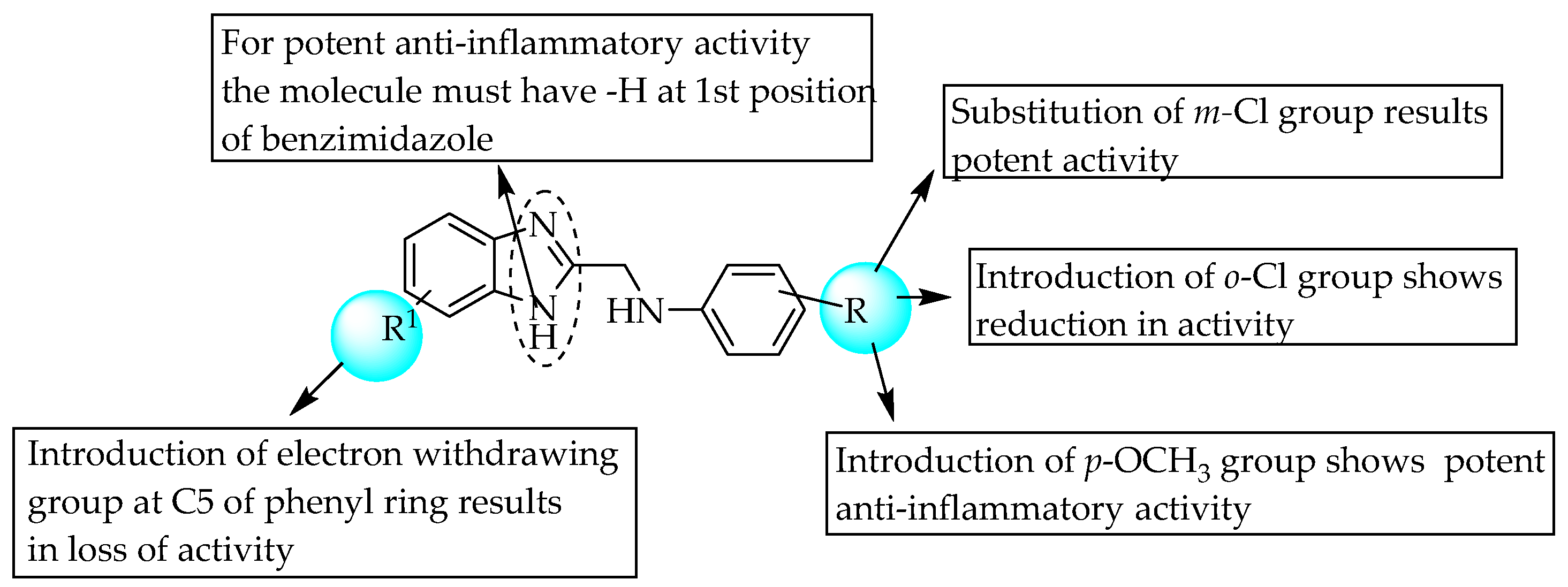

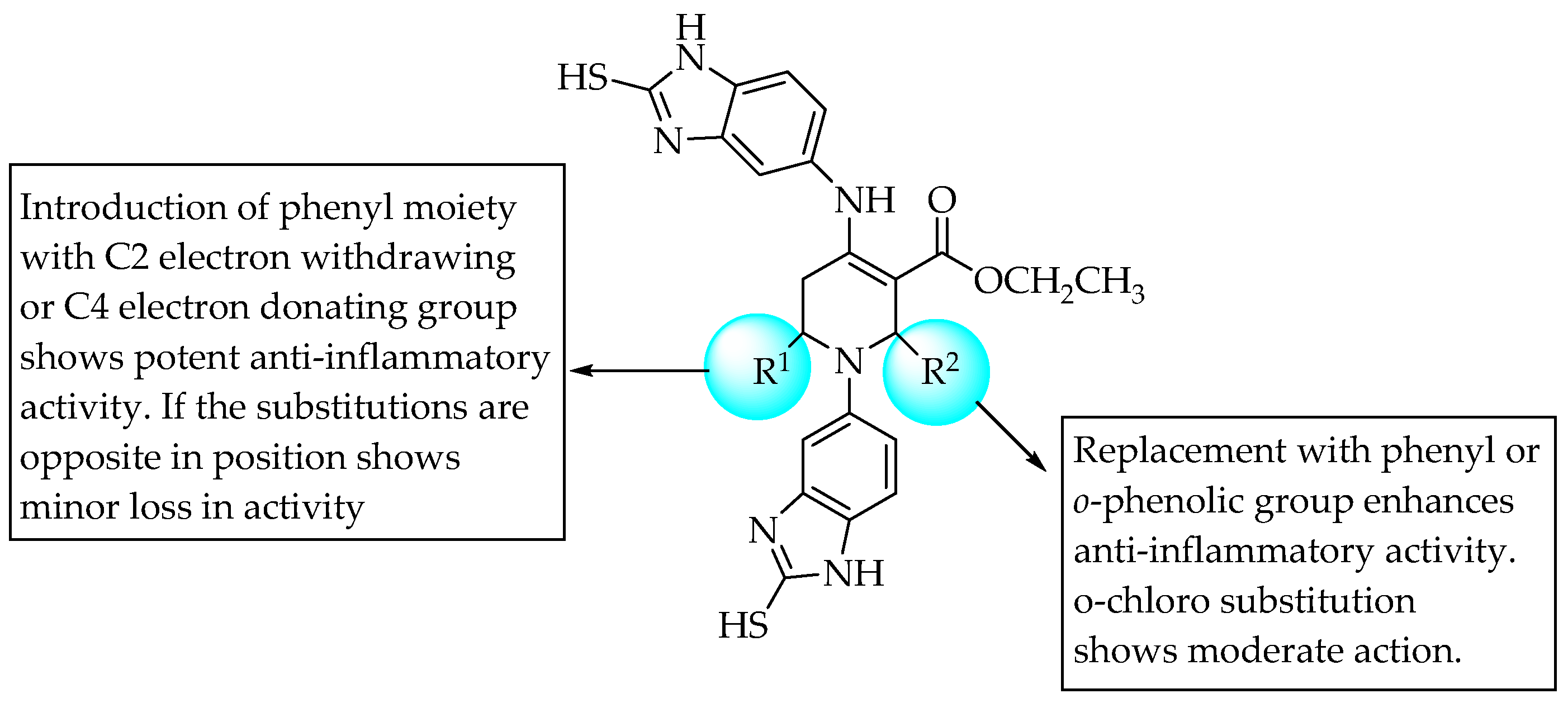


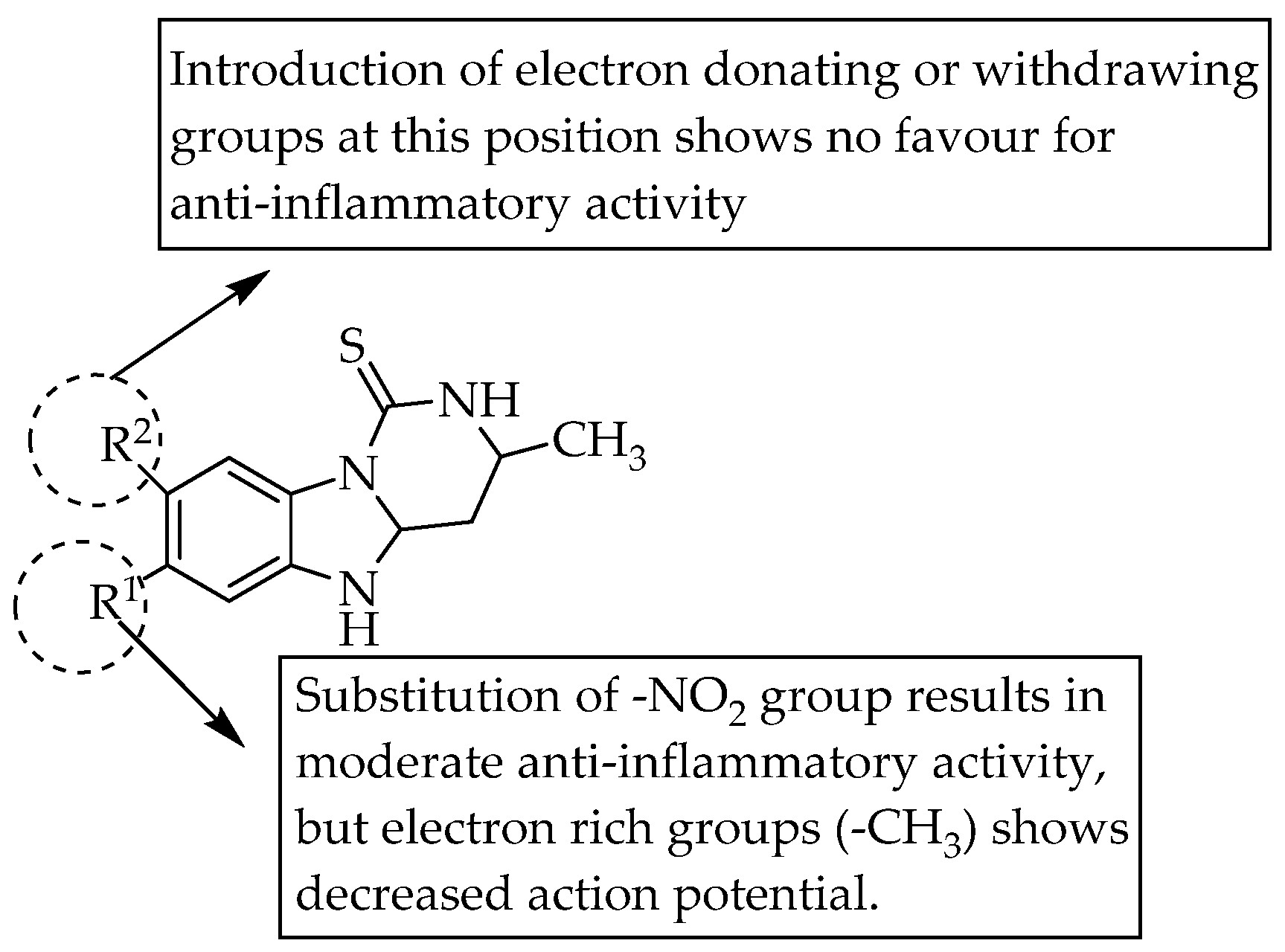
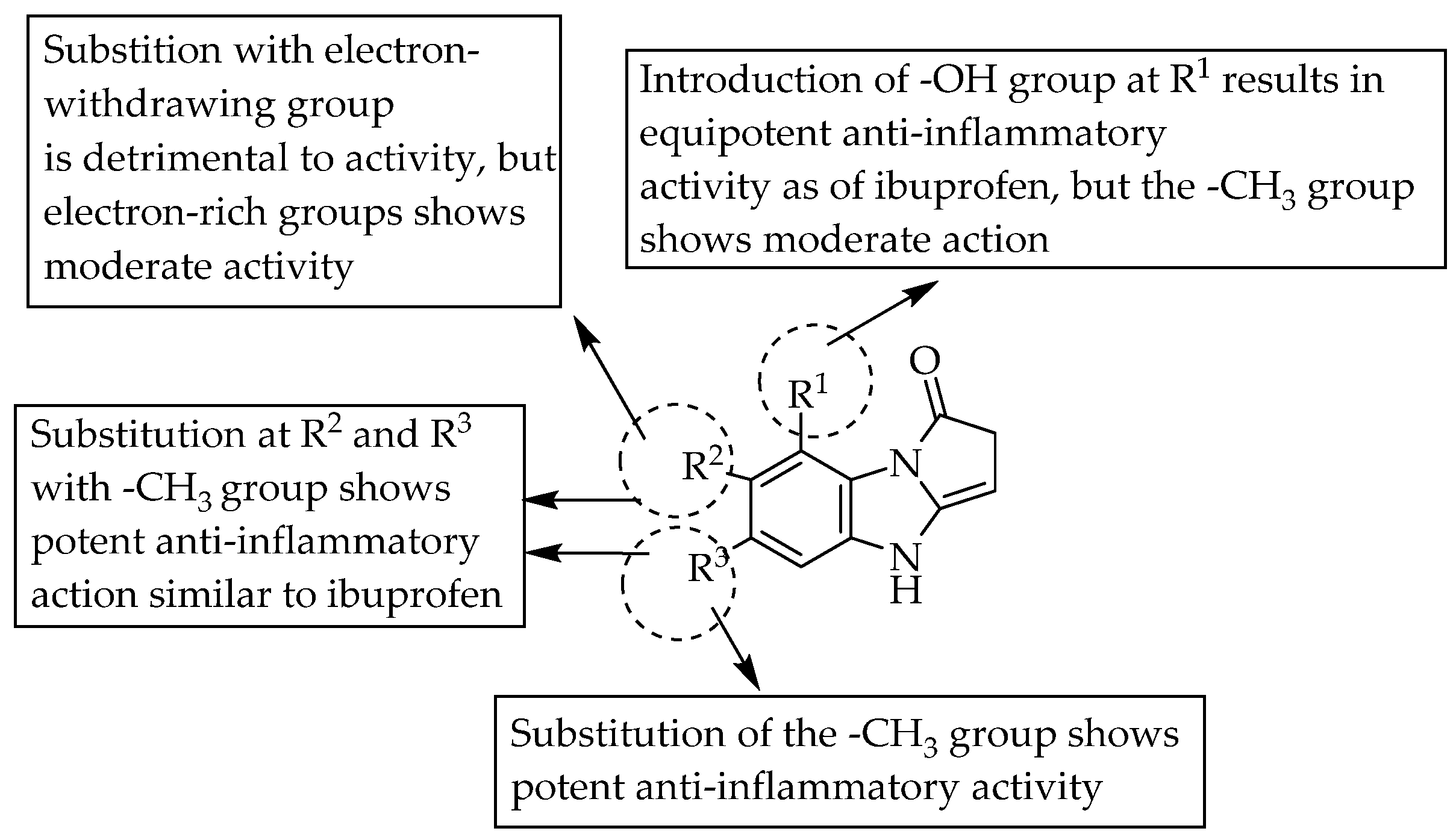
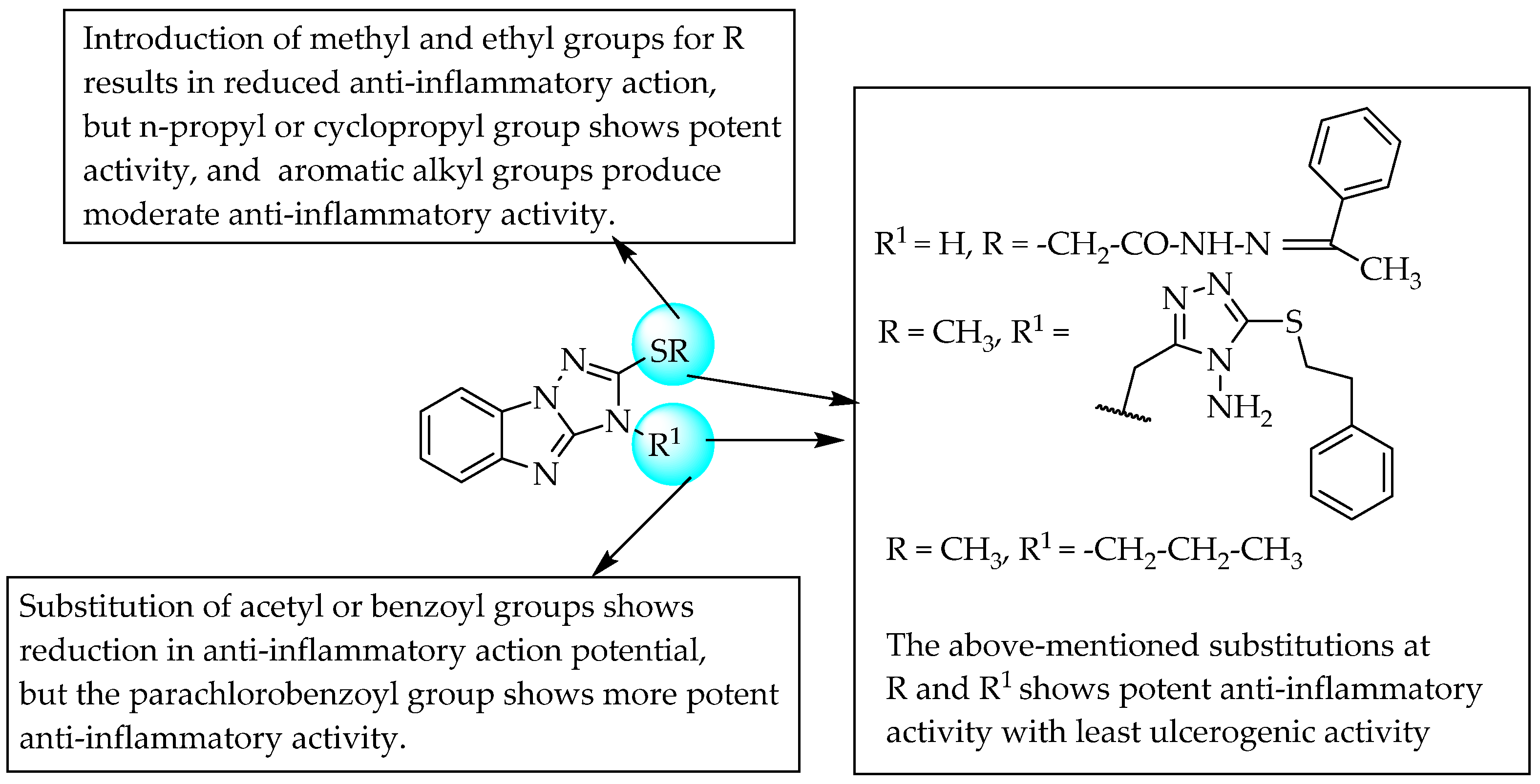


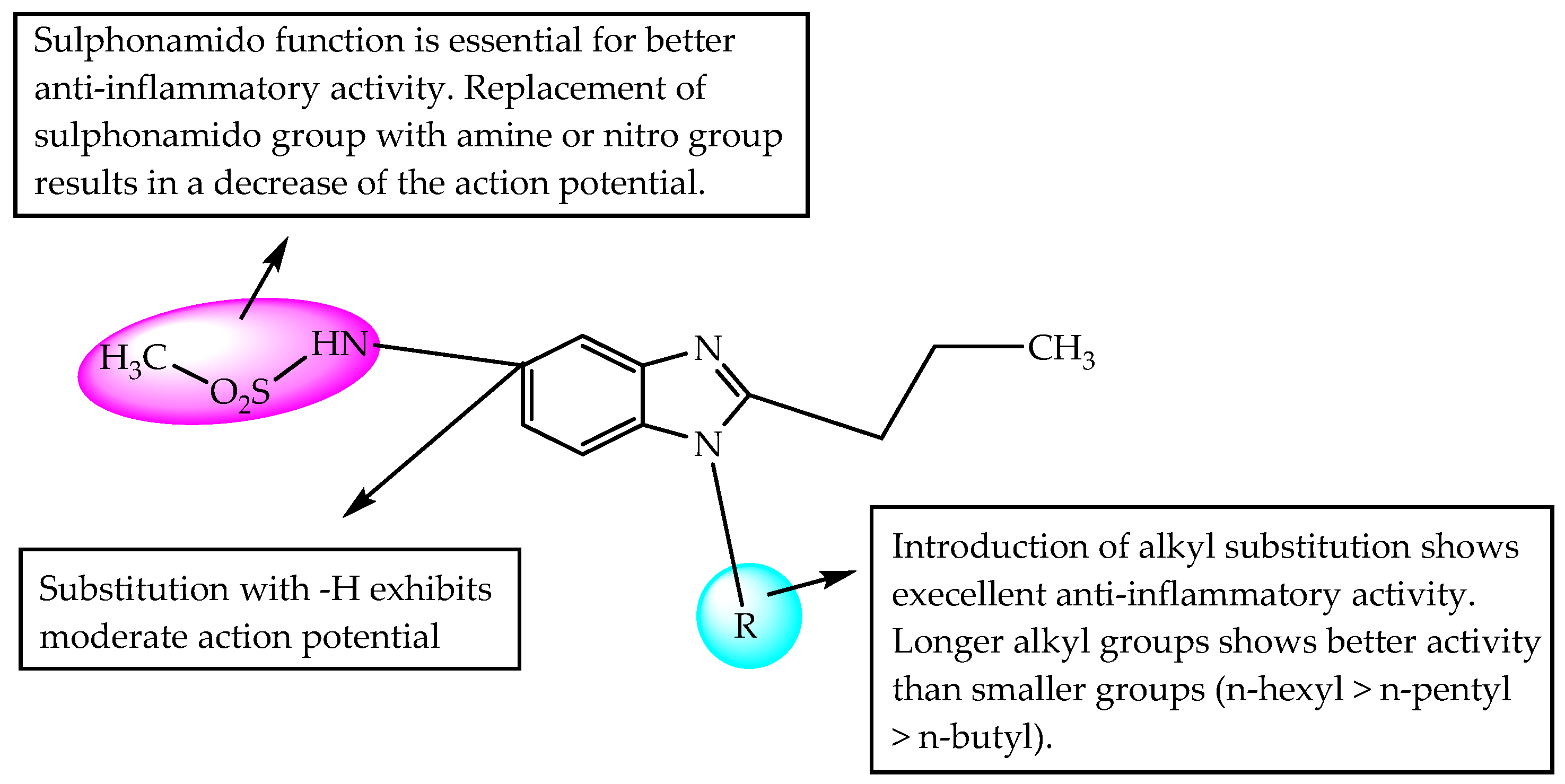
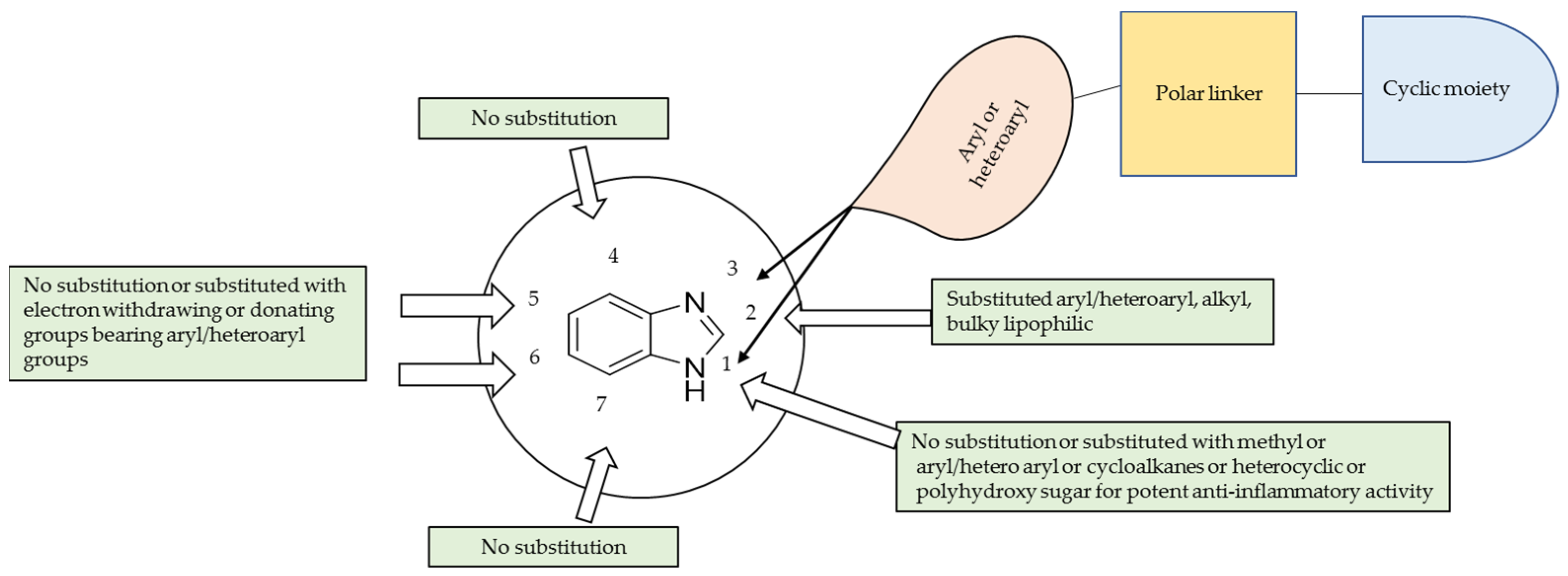
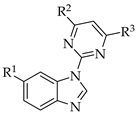
| Compound 2 | Compound 3 | |
|---|---|---|
| R1 | H | CN |
| R2 |  |  |
| R3 |  | H |
Publisher’s Note: MDPI stays neutral with regard to jurisdictional claims in published maps and institutional affiliations. |
© 2021 by the authors. Licensee MDPI, Basel, Switzerland. This article is an open access article distributed under the terms and conditions of the Creative Commons Attribution (CC BY) license (https://creativecommons.org/licenses/by/4.0/).
Share and Cite
Veerasamy, R.; Roy, A.; Karunakaran, R.; Rajak, H. Structure–Activity Relationship Analysis of Benzimidazoles as Emerging Anti-Inflammatory Agents: An Overview. Pharmaceuticals 2021, 14, 663. https://doi.org/10.3390/ph14070663
Veerasamy R, Roy A, Karunakaran R, Rajak H. Structure–Activity Relationship Analysis of Benzimidazoles as Emerging Anti-Inflammatory Agents: An Overview. Pharmaceuticals. 2021; 14(7):663. https://doi.org/10.3390/ph14070663
Chicago/Turabian StyleVeerasamy, Ravichandran, Anitha Roy, Rohini Karunakaran, and Harish Rajak. 2021. "Structure–Activity Relationship Analysis of Benzimidazoles as Emerging Anti-Inflammatory Agents: An Overview" Pharmaceuticals 14, no. 7: 663. https://doi.org/10.3390/ph14070663
APA StyleVeerasamy, R., Roy, A., Karunakaran, R., & Rajak, H. (2021). Structure–Activity Relationship Analysis of Benzimidazoles as Emerging Anti-Inflammatory Agents: An Overview. Pharmaceuticals, 14(7), 663. https://doi.org/10.3390/ph14070663






